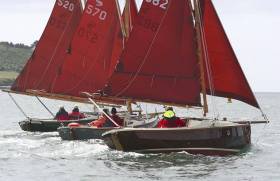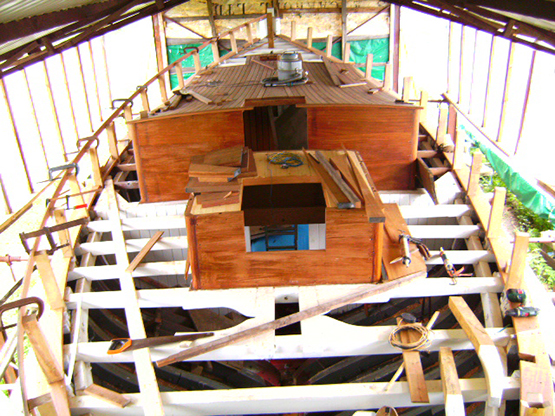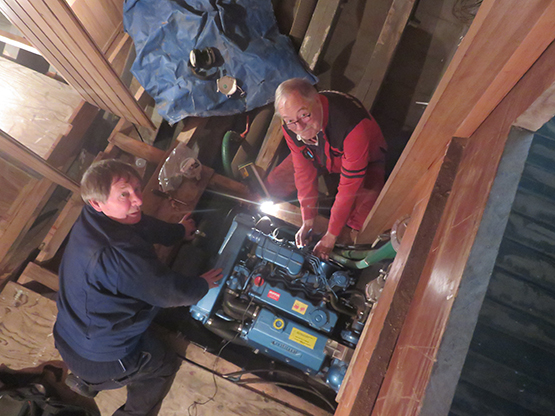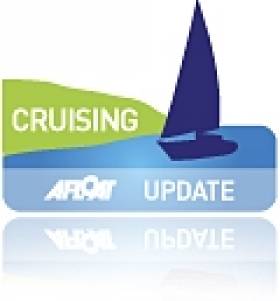Displaying items by tag: Old Gaffers Association
This weekend sees ancient gaff-rigged and other craft of multiple vintages gathering at Poolbeg Yacht and Boat Club in Ringsend in the heart of Dublin Port, within sight of some of the most modern ships afloat. It’s the 60th Anniversary of the Old Gaffers Association, and the fact that Dublin is central to the OGA’s Diamond Jubilee Cruise-in-Company speaks volumes for the welcome the port provided for the Golden Jubilee Cruise in 2013, when it became clear that owners of vintage or classical Bermudan-rigged boats were also welcome. It seems that being part of the community is a matter of the right attitude rather than undue fussiness about exactitude of rig.
Yet it’s a curiosity of international sailing history that in 1963 the definitive gaff-rigged One Designs of Dun Laoghaire - the 1902-originating Dublin Bay 21s - were in the process of changing to Bermuda rig. For at the same time, separate meetings in the south and southeast of England were - unbeknownst to each other – laying the foundations for the beginnings of the Old Gaffers Association for the preservation of gaff-rigged sailing skills.
THE MAN FROM THE ELEPHANT BOATYARD
As one of the main movers in the initial south coast meeting in Winchester was Mike Richardson of the renowned and distinctly characterful Elephant Boatyard on the upper reaches of the Hamble River, it’s not surprising that over the years, it was recognised that a contemporary meeting at Maldon in Essex was where the Old Gaffers Association really came into being.
 The rapid development of the OGA on England’s East Coast soon meant there was a keen Dutch branch, and they were present in strength in Dublin Bay in 2013, with the steel-built Cinne Mara (based on the design of a Galway hooker) seen here chasing fellow Dutch boat Raven, built to a Lyle Hess design. Photo: W M Nixon
The rapid development of the OGA on England’s East Coast soon meant there was a keen Dutch branch, and they were present in strength in Dublin Bay in 2013, with the steel-built Cinne Mara (based on the design of a Galway hooker) seen here chasing fellow Dutch boat Raven, built to a Lyle Hess design. Photo: W M Nixon
For they could focus on moving things forward in a single-minded way, whereas Mike of the Elephant and his friends – unaware of any developments on the East Coast – had so many boat interests on the go at the same time that the progressing of an idea for a new association had to take its place in the queue. For sure, they did eventually run a couple of races for old gaffers in the Solent. But once they realized that things had been happening in a more clear-cut form on the East Coast, the two groupings became one with the East Coast setting the pace.
INTERNATIONAL LINKS
Soon they were drawing in fellow enthusiasts, both countrywide and with international links. Success was such that by the time the Golden Jubilee came around in 2013, they had the strength and enthusiasm to organise a well-supported Round Britain Rally with many interesting ports visited, and with two stops on Ireland’s East Coast - at Poolbeg in Dublin, and in Belfast Port in Northern Ireland hosted by the NIOGA.
 Legends of the sea. Dickie Gomes, first winner in 2013 of the Leinster Plate with the 101-year-old Ringsend-built Ainmara, with Tim Magennis, President at the time of the hosting Dublin Bay Old Gaffers Association, and himself a veteran of a round the world voyage in the gaff-rigged Colin Archer ketch Sandefjord. Photo: W M Nixon
Legends of the sea. Dickie Gomes, first winner in 2013 of the Leinster Plate with the 101-year-old Ringsend-built Ainmara, with Tim Magennis, President at the time of the hosting Dublin Bay Old Gaffers Association, and himself a veteran of a round the world voyage in the gaff-rigged Colin Archer ketch Sandefjord. Photo: W M Nixon
The Irish stopovers were extensively covered on Afloat.ie with special enthusiasm, as your columnist happened to be sailing throughout all the happenings on the Irish coast with Dickie Gomes of Strangford Lough aboard the Ringsend-built 9-ton J B Kearney yawl Ainmara. And our enjoyment was in no way lessened by winning the inaugural race for the Leinster Trophy in Dublin Bay, with the trophy being handed over about 200 yards from where Ainmara had been born 101 years earlier.
 Even ten years ago, Bermudan rigged vintage boats were welcomed as OGA members, and here Ainmara is leading the inaugural race for the Leinster Plate in Dublin Bay at the OGA Golden Jubilee in 2013. Photo: Dave Owens
Even ten years ago, Bermudan rigged vintage boats were welcomed as OGA members, and here Ainmara is leading the inaugural race for the Leinster Plate in Dublin Bay at the OGA Golden Jubilee in 2013. Photo: Dave Owens
TWO IRISH BRANCHES HAVE BECOME ONE FOR ALL
Since then, the two Irish branches of the OGA have become one, with the DBOGA in effect covering the whole country, as the President is Adrian “Stu” Spence whose 47ft ketch El Paradiso is based in Ringhaddy Sound in Strangford Lough, while the Honorary Secretary Darryl Hughes now lives in Crosshaven, where he bases his 43ft gaff ketch Maybird, designed by Fred Shepherd and built by Jack Tyrrell of Arklow in 1937.
This national spread is further emphasized by former international OGA President Sean Walsh – in 2013, he was Dun Laoghaire-based with his Heard 28 gaff cutter Turn a nOg – now being a Kinsale sailor. He and Darryl Hughes have combined forces to sail Tir na nOg east and north to Ringsend to help co-ordinate the Poolbeg events, which are under the overall direction of Adrian Spence and former PY&BC Commodore Johnny Wedick.
 Local boats join the international fleet – Sean Walsh’s Tir na nOg from Dun Laoghaire dicing in Dublin Bay with Paul Holden’s Peapod from Howth. Photo: Dave Owens
Local boats join the international fleet – Sean Walsh’s Tir na nOg from Dun Laoghaire dicing in Dublin Bay with Paul Holden’s Peapod from Howth. Photo: Dave Owens
The friendly atmosphere in Poolbeg Y & BC lends itself well to mutlti-generational events of this type, an excellent example being the recent launching of marine and civic historian Cormac Lowth’s fascinating book about the Ringsend sailing trawlers. The Ringsend fishery began to be of major significance when the Brixham fishermen from Devon started expanding their operations after the ending of the Napoleonic Wars around 1818. And they succeeded so well in their new Ringsend base that by the 1880s the renowned Murphy family in Ringsend built and very successfully fished the largest Brixham-type fishing boat ever, the legendary St Patrick.
 So successful were the Ringsend fishermen in adopting and developing the technology brought to them by their immigrants from Brixham that the largest fishing boat built to the Brixham trawler concept was the famous St Patrick – designed, built and fished by the Murphy family of Ringsend. Photo: Courtesy Cormac Lowth
So successful were the Ringsend fishermen in adopting and developing the technology brought to them by their immigrants from Brixham that the largest fishing boat built to the Brixham trawler concept was the famous St Patrick – designed, built and fished by the Murphy family of Ringsend. Photo: Courtesy Cormac Lowth
RAYTOWN
Modern developments on the Ringsend waterfront mean that it is now difficult to imagine this area as a thriving fishery services foreshore, but such was very much the case. And the visit of a group such as the Old Gaffers is a timely occasion to reflect on the period when this was known to Dubliners as Raytown. The local fishing community kept the despised ray for their own consumption while selling the more profitable sought-after species. Consequently it was observed that you could find Ringsend in fog or total darkness relying only on the all-pervading smell of ray being wind-dried on lines for preservation for winter consumption.
THE DUN LAOGHAIRE WAY
Needless to say the arrival of the idea of local Old Gaffers Associations in Ireland was greeted with mixed feelings. It’s doubtful if those such as Cass Smullen, who were arguing to keep the DB21s gaff-rigged, would have been known that at the same time two separate groups in England were thinking in the same general way. Or if he did, then he would have been well aware that support from that quarter might not have helped his cause at all, as Dun Laoghaire has always liked its own way of doing things.
 The Dublin Bay 21 Geraldine arrives back in Dun Laoghaire on Wednesday of this week, after being re-born under the skills of Steve Morris of Kilrush Boatyard. Photo: DB21
The Dublin Bay 21 Geraldine arrives back in Dun Laoghaire on Wednesday of this week, after being re-born under the skills of Steve Morris of Kilrush Boatyard. Photo: DB21
 The restored DB21 Garavogue, setting her new “American gunter” rig, winning the last race of the 2022 season. The Dublin Bay 21s had decided to change to Bermudan rig in 1963 just as the Old Gaffers Association came into being to preserve gaff rig and the skills needed to use it.
The restored DB21 Garavogue, setting her new “American gunter” rig, winning the last race of the 2022 season. The Dublin Bay 21s had decided to change to Bermudan rig in 1963 just as the Old Gaffers Association came into being to preserve gaff rig and the skills needed to use it.
For despite the interest in Bermuda rig, the fact is we were up to our tonsils in gaff rigged boats, and still are. But they are mainly used very actively for racing, such that boats like the Dublin Bay Water Wags and the Howth 17s don’t see themselves as Old Gaffers at all - on the contrary, their self-image is of a hot racing class which just happens to be gaff rigged.
ENGLISH CULTURAL IMPERIALISM?
This relaxed acceptance of gaff rig as being very much alive and a natural part of the contemporary Irish sailing scene was brought home to me many years ago when an English gaff-rigged enthusiast called Alan Hidden arrived to work in Northern Ireland, and although a decent enough person, he carried the usual baggage of English cultural imperialism in some maritime matters.
 One of the most interesting boats due in Poolbeg is the former Bristol Channel Pilot Cutter Letty of 1905 vintage. But don’t assume that her impressive presence will be a subtle case of English maritime cultural imperialism. Her owner-skipper Steve Cogdell proudly flies the Cornish ensign, which suggests that he and his crew see themselves as being completely independent of just about everyone else on the planet. Photo: Patrick Vyvyan-Robinson
One of the most interesting boats due in Poolbeg is the former Bristol Channel Pilot Cutter Letty of 1905 vintage. But don’t assume that her impressive presence will be a subtle case of English maritime cultural imperialism. Her owner-skipper Steve Cogdell proudly flies the Cornish ensign, which suggests that he and his crew see themselves as being completely independent of just about everyone else on the planet. Photo: Patrick Vyvyan-Robinson
For very soon, we had a letter from him to Afloat Magazine saying that he had discovered a marvellous old clinker-built gunter-rigged 14ft sailing dinghy called Mantis which once upon a time had belonged to a “long extinct” class called the Ballyholme Insects, and his plan was to restore her and use her as the foundation on which to build a Northern Ireland branch of the Old Gaffers Association.
THE PICKLE FORK CLUB
“Mixed feelings” barely begins to describe the reaction in the luxuriously-appointed editorial offices of Afloat Verbiage Industries plc.. For once upon a time, we owned, sailed, raced, cruised and did many others things of a rites-of-passage and highly educational nature with an Insect. Thus the thought that somebody should see them as quaint Old Gaffers was appalling.
Worse still was kitting an Insect with tan sails sporting an OGA number and the Old Gaffer symbol. It’s supposed to be based on a set of classic gaff boom jaws, but a totally Bermuda-rigged shipmate always refers to the OGA as “The Pickle Fork Club”, and on this evidence of English cultural imperialism as applied to a Ballyholme Insect, I was inclined to agree with him.
 Sacrilege! The Ballyholme Insect Class Mantis being re-purposed as a propaganda tool for the Old Gaffers Association, showing clearly why sniffy Bermuda-rig enthusiasts refer to the OGA as “The Pickle-Fork Club”. This photo of Mantis was taken at the very tidal inlet of Dundrum on the County Down coast, where Regatta Day is selected so that at low water ponies can conveniently be raced around the same course that sailing craft use at high water.
Sacrilege! The Ballyholme Insect Class Mantis being re-purposed as a propaganda tool for the Old Gaffers Association, showing clearly why sniffy Bermuda-rig enthusiasts refer to the OGA as “The Pickle-Fork Club”. This photo of Mantis was taken at the very tidal inlet of Dundrum on the County Down coast, where Regatta Day is selected so that at low water ponies can conveniently be raced around the same course that sailing craft use at high water.
THE DBOGA ARE OKAY
Until, that is, I found that the Dublin Bay Branch of the Old Gaffers Association included such solidly maritime souls as Tim Magennis and Johnny Wedick and Denis Aylmer and the merry band with Paul Keogh on the Clondalkin-built Galway hooker Naomh Cronan and many others.
So we threw ourselves with enthusiasm into the DBOGA’s prominent role in the Golden Jubilee Celebrations in 2013, albeit with the Bermudan-rigged Ainmara. But then, her antique Ringsend associations probably gave her more right to be there than any other boat in the fleet.
 Solid sailing citizen. DBOGA pioneer Dennis Aylmer of Dun Laoghaire may sail the “plastic fantastic” Mona these days, but back in the 1960s he was one of the key enthusiasts for Galway Hookers in Dublin Bay.
Solid sailing citizen. DBOGA pioneer Dennis Aylmer of Dun Laoghaire may sail the “plastic fantastic” Mona these days, but back in the 1960s he was one of the key enthusiasts for Galway Hookers in Dublin Bay.
Yet now with the Diamond Jubilee upon us, it’s disconcerting to find how much has changed in just ten years, which you’d think in Old Gaffer terms is just the twinkling of an eye. Ainmara has been sold to Swiss owners, Adrian Spence’s 1873-built Madcap has been sold to France, Joe Pennington’s Master Frank, the pride of the Isle of Man, is very much on the market, and now the Naomh Cronan is based in Galway.
THE GOOD NEWS
Yet the news is not all one way. On the upside, Hal Sisk and Fionan de Barra of Dun Laoghaire are more than halfway towards the restoration of the Dublin Bay 21 Class, with the arrival in Dun Laoghaire this week of the newly-restored Geraldine from the skilled hands of Steve Morris and his team in Kilrush.
 Current DBOGA President Adrian Spence (right) absorbing wisdom (and much else) with old salts Joe Pennington (left) and Dickie Gomes. Photo: W M Nixon
Current DBOGA President Adrian Spence (right) absorbing wisdom (and much else) with old salts Joe Pennington (left) and Dickie Gomes. Photo: W M Nixon
And in Strangford Lough, the classic Manx nobby White Heather has returned, complete with her authentic widow-maker of a dipping lug rig, brought back to her longtime home by Gary Lyons who apparently more or less did a straight swap with his vintage Bermuda ketch Ocean Dove with previous White Heather owner Mike Clarke of Peel.
And as for this weekend at Poolbeg, the fact that all places were booked out within a few days of bookings becoming available tells us that the OGA – and Poolbeg Yacht & Boat Club with it - are in good health.
 Summer’s evening at Poolbeg in Dublin Port during the 2013 visit of the Old Gaffers Association. Photo: W M Nixon
Summer’s evening at Poolbeg in Dublin Port during the 2013 visit of the Old Gaffers Association. Photo: W M Nixon
These past few days have been purest serendipity for historic Irish boatbuilders. Just two days after the 1926-vintage West Cork-built Limerick ketch Ilen was celebrated beside the River Thames in London on Wednesday, the 1937 Tyrrell of Arklow 43ft ketch Maybird was being honoured last night beside the River Liffey in Dublin Port. In fact, the legendary Arklow boat-builder Jack Tyrrell was up in lights twice over, as last night’s (Friday) gala Awards Ceremony of the Dublin Bay Old Gaffers Association in the Poolbeg Yacht & Boat Club also saw the inauguration of a new trophy, celebrating the memory of a former owner of the 1963 Tyrrell-built vintage Bermudan sloop Tjaldur.
We’d best take things chronologically. As Ilen’s date with destiny beside Tower Bridge for a first London cultural-exchange visit came up the agenda on Wednesday, not all the ducks were staying neatly in a row. Award-winning actor Dominic West of Glin Castle on the Shannon Estuary was finding serious diary problems in taking up his role as MC.
CELEB STAKES: HOW TO UP-GRADE FROM A BAFTA TO AN OSCAR
But not to worry. Ilen Marine School Director Gary Mac Mahon has a contacts book worth much more than its weight in gold. So you’ve a problem? You can’t get a BAFTA-winning thesp from a castle on the Shannon for your long-planned big event in London? No problem. Get an Oscar-winning superstar from a castle in West Cork instead, and the show is even more firmly on the road.
 Dr Mick Brogan, Gary Mac Mahon, Sinead Cusack and Jeremy Irons at the Ilen London Reception. Photo: Claire Frew
Dr Mick Brogan, Gary Mac Mahon, Sinead Cusack and Jeremy Irons at the Ilen London Reception. Photo: Claire Frew
In fact, as Jeremy Irons – who would call over betimes from nearby Kilcoe Castle to see Ilen while she was being restored by Liam Hegarty in the boatyard at Oldcourt – also brought his wife Sinead Cusack with him to the Ilenfest at St Katharine Docks on Wednesday, it was a stardust event, with the marine element including the distinguished Chairman of Crunnui na mBad in Kinvara on Galway Bay, Dr Mick Brogan, while the exchanges of goodwill were headed by speeches from Alison Gowman, Sheriff of the City of London, and Councillor Daniel Butler, the Mayor of Limerick.
 Ilen well-wishers starting to gather in the ultimate urban setting. Photo: Alistair Craig
Ilen well-wishers starting to gather in the ultimate urban setting. Photo: Alistair Craig
BUSY NIGHT IN DUBLIN PORT
With the main event safely logged, Ilen’s Thames Estuary calendar is filling up over the next few days. But meanwhile, last night in Dublin Port saw an impressive number of boxes being ticked as the Dublin Bay Old Gaffers moved into post-pandemic overdrive, with minds well-focused by the presence of Old Gaffers Association overall President Patrick Vyvyan-Robinson.
 Patrick Vyvyan-Robinson from Wales, President of the Old Gaffers Association
Patrick Vyvyan-Robinson from Wales, President of the Old Gaffers Association
He’s a dyed-in-the-wool four-sided mainsail man who cruises the traditional-style Heard 28 Capraia out of the Bristol Channel and southwest England. But in coming to Poolbeg he was able to savour the essence of Irish Old Gafferry, for although the traditional boats of Galway Bay and Connemara continue in their own magnificent solitary splendour, in the rest of the island the Old Gaffers have rationalised themselves into the one setup, the Dublin Bay Old Gaffers Association. Its widespread reality is reflected in the fact that the current President is northerner Adrian “Stu” Spence with the ketch-rigged Vagabond 47 El Paradiso, while the Honorary Secretary is Crosshaven-based Darryl Hughes with the 43ft 1937 Tyrrell ketch Maybird.
OGA President Vyvyan-Robinson was there to personally present one of the main association’s top trophies - the Jolie Brise Cup - to Paul Keogh of Dublin for his tireless work over 25 years and more in keeping the Clondalkin community-built Galway Hooker Naomh Cronan in good order and busy afloat throughout the Irish Sea and beyond.
SIXTY YEAR CELEBRATIONS ON HORIZON
And as well the President was there to remind everyone that 2023 will be the OGA’s 60th anniversary. The Golden Jubilee in 2013 saw the Dublin Port stopover being one of highlights of the celebratory Cruise-in-Company, so the building blocks are being put in place to make sure that 2023 can provide the same or even better for the 60th.
The Tyrrell ketch Maybird has had several rigs and re-rigs in her 85 years, and as she is also the oldest boat ever to have completed the Round Ireland Race, Darryl Hughes reckoned that a bit of one of her discarded masts could be usefully re-purposed as a prize for future holders of the “Oldest Boat to Complete” in Round Ireland Races, and for that the “Maybird Mast” trophy was entrusted to Round Ireland organizer Hal Fitzpatrick of Wicklow Sailing Club.
 The 1937 Tyrrell of Arklow-built ketch Maybird is owned and sailed by DBOGA Honorary Secretary Darryl Hughes
The 1937 Tyrrell of Arklow-built ketch Maybird is owned and sailed by DBOGA Honorary Secretary Darryl Hughes
DBOGA President Stu Spence sailed many thousand of coastal and offshore miles in the 1874-vintage gaff-rigged pilot cutter Madcap, but now he has relaxed into the furling Bermuda comforts of the Vagabond 47 El Paradiso. However, the word is that he and fellow Arctic veteran Paddy Barry will have Paradiso up beyond Svalbard in the high Arctic this summer, but meanwhile in acknowledgement of the fact that classic Bermudan-rigged boats play a significant role in today’s OGA, he introduced the Tjaldur Trophy in honour of the late and much-missed Sean Whiston, who sailed the 1963 Peter Brett-designed Tyrrell-built 13-tonner Tjaldur for many happy years, the new trophy in his memory to go to the top-place Bermudan-rigged boat in the annual DBOGA Regatta.
 DBOGA President Adrian Spence’s Vagabond 47 El Paradiso. His previous boat for very many years was the 1874-built Pilot Cutter Madcap. Photo: W M Nixon
DBOGA President Adrian Spence’s Vagabond 47 El Paradiso. His previous boat for very many years was the 1874-built Pilot Cutter Madcap. Photo: W M Nixon
The DBOGA has been exemplary in keeping things going through the lockdowns with a series of Zoom sessions on a wide variety of nautical topics, and in keeping with their traditions, they introduced the electronic equivalent of donating to the yellow welly for the Howth lifeboat, and Howth lifeboat fund-raiser Rose Michael – who will be marking forty years of raising the wind for the lifeboats next year – was there to receive the large ceremonial cheque as another highlight of the DBOGA’s many and various activities.
 The late Sean Whiston sailing his 13-ton Tyrrell-built sloop Tjaldur
The late Sean Whiston sailing his 13-ton Tyrrell-built sloop Tjaldur
Dubliner Paul Keogh Receives Top Trophy For His Dedication to Promoting Traditional Gaff Rig
For many years until her transfer to Galway in 2021, the Clondalkin community-built Galway Hooker Naomh Cronan was a feature of sailing life in Dublin’s River Liffey at Poolbeg Y&BC in Ringsend, and she was a regular attendee at traditional and classic boat events throughout the Irish Sea and further afield.
Maintaining both her seaworthiness and the high level of activity which was central to her successful existence involved many people, but the one man who became known as “The Keeper of the Show on the Road” was Paul Keogh, who was her Sailing Manager for eighteen years after joining the building team which brought her construction to completion.
 The result of a remarkable community effort – the Clondalkin-built Galway Hooker Naomh Cronan in Dublin Bay. Photo: W M Nixon
The result of a remarkable community effort – the Clondalkin-built Galway Hooker Naomh Cronan in Dublin Bay. Photo: W M Nixon
Paul’s quiet yet very determined enthusiasm, and his sometimes heroic patience as he ensured that Naomh Cronnan was always fully crewed - with newcomers being steadily recruited to the cause - was something for celebration. So when it came to a close in the summer of 2021 with the Cronan’s satisfactory transfer to Galway City custodianship, his fellow members of the Dublin Bay Old Gaffers Association began preparing a proposal that Paul’s unique contribution should receive the ultimate recognition, the Jolie Brise Trophy, which is the supreme award of their central organisation, the Old Gaffers Association.
 She really is breath-taking – the magnificent Jolie Brise making knots
She really is breath-taking – the magnificent Jolie Brise making knots
The award was confirmed in the online and partly active Annual General Meeting of the OGA in Newcastle in northeast England at the weekend, and will be followed by a further presentation in Dublin in due course. Meanwhile, it is timely to note that in celebrating Paul Keogh’s achievement, we are also celebrating what is arguably the greatest working gaff cutter ever built, the 56ft 1913-vintage Le Havre pilot cutter Jolie Brise. She served only briefly on pilot duties before being superseded by powered vessels, but since then has gone in to an unrivalled career as an offshore racer – she won three Fastnet Races – and sail training vessel.
 An impression of latent power – Jolie Brise in Belfast Lough in 2015, on her way to being overall winner of that season’s Tall Ships Races. Photo: W M Nixon
An impression of latent power – Jolie Brise in Belfast Lough in 2015, on her way to being overall winner of that season’s Tall Ships Races. Photo: W M Nixon
Jolie Brise is a frequent visitor to Ireland, a notable occasion being in 2015 when she was in Belfast Lough during that year’s programme of Tall Ships Race, in which she excelled herself by being winner of both her class and the overall fleet when the series concluded. She is a magnificent vessel which never fails to excite admiration, and young Tom Cunliffe - the John Arlott of English sailing – captures it well in this enthusiastic video
Cornish Shrimpers – Old Gaffer Style With Compact Modern Convenience
With the current prospect of foil-borne IMOCA 60s disappearing towards the horizon at phenomenal speeds in the Vendee Globe Race to remind us of how modern life is just all rush and bustle, we could be forgiven for thinking in terms of getting relaxation afloat with a style of sailing which is about as different as possible writes W M Nixon.
Thus you’d get to thinking in terms of traditional rig and old-fashioned looks in terms of hull shape. But then, it being that time of the year when maintenance planning and its inevitable expenditure is coming top of the agenda, you get to thinking that old-fashioned and winter expense are so often synonymous. So all hail the plastic gaffer. Or more accurately, the new plastic old gaffer.
Both the current and previous International Presidents of the Old Gaffers Association sail the seas in plastic gaffers, and they do such a good job of it that nobody thinks any the less of them for having boats which by-pass the maintenance expense of traditional timber craft. And Denis Aylmer, the top honcho in the Dublin Bay Old Gaffers Association, likewise is plasticized while still gaffing, though it should be remembered that in his much younger days he more than did his duty in preserving Galway hookers which others had thought were beyond saving.
As you get further down this line of sensible traditional-through-plastics line of thought, the logic suggests as small a boat as possible which can properly qualify as an Old Gaffer, yet still be a boat which can be reasonably conveniently road-trailed to your summer’s sailing area.
It might be stretching it a bit to describe the Cornish Shrimper 19 as a trailer-sailer. But as Afloat Boats for Sale currently carries ads for two of these attractive character boats with one in Whitehead in County Antrim and the other in Kilmore Quay in County Wexford, the fact that most Irish sailors would have to think of a journey to get them home adds to their appeal as a very manageable road trail.
As to how you use them, most folk see them as day sailers, but in the Classic version there are two bunks, and the 2 + 2 variant can actually sleep four. That’s thanks to the ingenious incorporation of a V-berth right forward, but frankly you’d need to be very good friends to think of utilising that option.
Cornish Crabbers have been building the Cornish Shrimper 19 since 1979, and more than a thousand now sail the sea. They inspire their own special camaraderie for class rallies and other gatherings. But equally they can give a good showing of themselves in open gaffer events. The one in Whitehead is priced at €12,000, while the one in Kilmore Quay is €15,900 – either way, they’re the perfect antidote if you’re suffering from IMOCA 60 fatigue.
Christmas Dreams Of Irish Wooden Boats – Old & New, Real & Fantasy
The season is upon us for goodwill and dreams of very special gifts. And for many Irish sailors, the dream Christmas present would be an elegantly classic or solidly traditional wooden boat, with all maintenance and running costs somehow covered by Divine Providence into infinity……W M Nixon goes down the Yuletide timber trail.
Love of wood is part of what we are. It’s in our genes. At some times and some places in the remote past, an instinctive fondness for wood, and an inherited ability to do something useful with it, would make all the difference between survival and extinction. So though today the availability of other more purposeful materials may have transformed boat-building, a new boat without some sort of wood trim is a very rare thing indeed.
At a more personal level, many of today’s generation of sailors cherish family memories of the communal building of wooden DIY kit boats at home. Here, there and everywhere, a drawing room or little-used dining room found itself a useful new purpose as a boat-building salon, with Mirror dinghies and occasionally larger craft taking shape in domestic settings throughout the land.
“Our daddy the boat-builder” became a household name in his own household. And for those who sometimes wonder why today’s adult sailors can become misty-eyed at the very thought of the Mirror dinghy (which really was and is a wonderful design and concept), the answer surely is that at a significant stage of their sailing and family life, a Mirror dinghy was centre stage, the symbol of a family’s shared values, hopes and interests.
But maybe the most important thing about the Mirror is that she is so eminently practical. So perhaps at Christmas we should allow our imaginations to take flight and soar high to envisage the complete wooden dreamship. And there she is as our header image, introducing this week’s meandering thoughts. That schooner at the moment is total fantasy. But any sailing enthusiast who looks at that concept design and doesn’t think: “Now there’s my dreamship”, well, he or she just doesn’t have a true sailing soul.
The origins of Eirinn, as she is named for the time being, go back to 2012, when the nascent Atlantic Youth Trust sought suggestions as to what a new sail training vessel for all Ireland should look like. But with their proposals recently getting the first real hints of a fair wind from both governments, the AYT have gone firmly down the route of a 40 metre steel barquentine.

The Ilen as she was in the Spring of 2015 in Oldcourt...
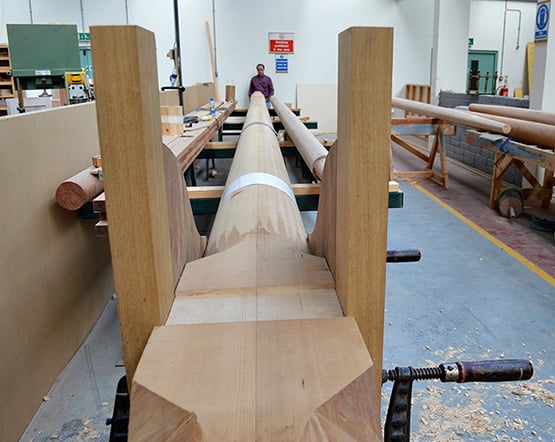 ….while in the Ilen Boatbuilding School in Limerick, spars and deckhouses were taking shape
….while in the Ilen Boatbuilding School in Limerick, spars and deckhouses were taking shape
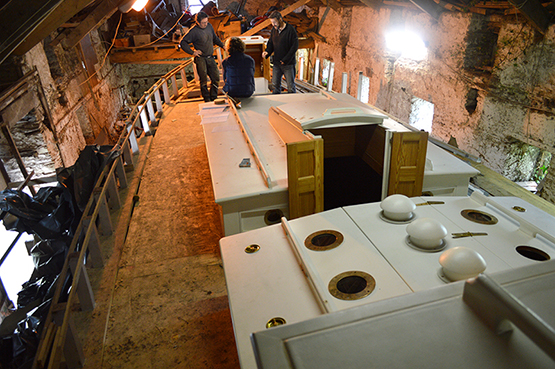
Deckhouses built in Limerick are offered up on the Ilen in Oldcourt
However, down in Limerick where they were busy with moving forward the restoration of the Conor O’Brien 1926 ketch Ilen at two sites – the hull with Liam Hegarty in Oldcourt near Baltimore in West Cork, and the deckhouses, spars and other smaller items being built at the Ilen Boat Building School in Limerick – they gave some thought in 2012 to the possible form of a new sail training vessel. They came up with the concept of a classic 70ft schooner which they knew, thanks to the work on Ilen, that they could build themselves using the skills learned and deployed in re-building the O’Brien ketch.
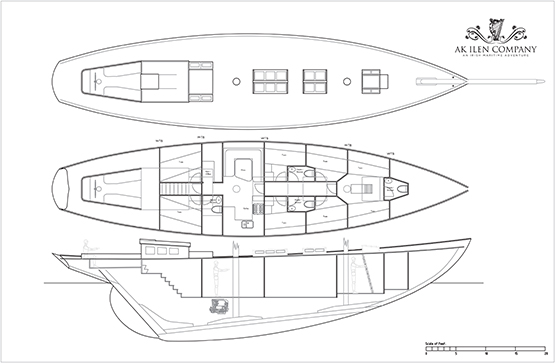
A classic hull for a classic schooner – Theo Rye’s profile and general arrangements plan for the schooner concept of 2012
But with the Ilen project moving steadily on towards the vessel’s commissioning next summer, and with other directly-related new proposals at an advanced stage in the pipeline, that sublime schooner concept is in a sort of limbo, truly a fantasy.
Yet she’s such a lovely thing that we’re happy to use her as our symbol of Christmas cheer. Her creators are Gary MacMahon of the Ilen Boatbuilding School, and Theo Rye, who is best known as a technical consultant in naval architecture, and on clarifying matters of design history and detail in boat and yacht design. But he can turn his hand to all sorts of design commissions if required. He came up with the clever concept for the CityOne dinghies in Limerick, and when Gary started musing about a classic training schooner, within the scope of what the Ilen school could do, as their answer to the AYT sail training vessel query, Theo came up with the goods and then some.
In fact, the design of the hull is so perfect that we’ll run it again right here to save you the trouble of scrolling back to the top. The overhangs at bow and stern are in harmony, but it is the sheerline which is the master-stroke. There isn’t anything you’d want to change in it, yet when you look at other famous schooners such as the fictional Southseaman (in real life she was Northern Light) in Weston Martyr’s masterpiece of maritime literature The Southseaman – the Story of a Schooner (1926), we see a sheerline which is too flat in the way of the foremast. But with Eirinn, the curve is just right, and it’s something achieved by tiny adjustments and balances which the eye can’t really perceive, yet somehow it registers the sublime harmony of the total concept.
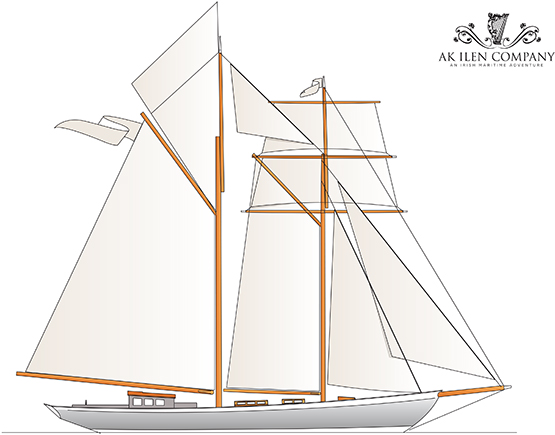
Worth a second look – and then a third one. The longer you look at the lines of Eirinn, the sweeter they seem. But her overall appearance might be improved with a slight rake of the masts
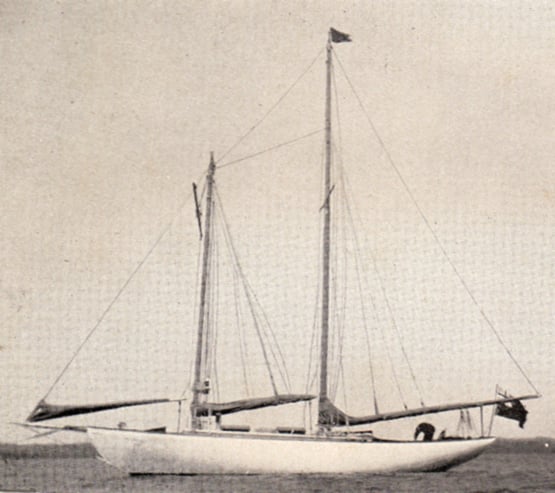 A schooner sheer not quite right – Weston Martyr’s Southseaman (aka Northern Light) could have done with a livelier sheerline abeam of the foremast.
A schooner sheer not quite right – Weston Martyr’s Southseaman (aka Northern Light) could have done with a livelier sheerline abeam of the foremast.
So Theo Rye not only writes critiques of other people’s designs, but if given the chance he can personally come up with something which is wellnigh impossible to fault. Of course, we mightn’t quite go for the same rig – a little bit of rake in the masts wouldn’t go amiss - and for private use you’d want something a little different from the dormitory layout of the training ship. But that said, this is a beautiful yet not excessively pretty-pretty hull, a boat which sings. And the fact that she’s beyond just about every private owner’s reach only adds to the mystique.
But to redress the balance, last week we’d an inspiring evening’s entertainment and information about a dreamship which really is being re-created. It was the December gathering of the Dublin Bay Old Gaffers Association in the ever-hospitable Poolbeg Y & BC, and a full house was there to hear about how Paddy Murphy of Renvyle in the far northwest of Connemara is getting on with his mission of bringing the famous Manx sailing nobby Aigh Vie back to life.
Paddy himself is something special. When asked his trade, he says he’s a blacksmith. But he can turn his hand to anything. Originally a Dub, his early sailing experiences included owning a Flying Fifteen and a Dragon, though not – so far as I know – at the same time. But then got the gaff rig traditional boat bug, and a sail on Mick Hunt’s Manx nobby Vervine Blossom sent him in pursuit of near-sister Aigh Vie. She was reportedly for sale, having for a long time been the pet family cruising boat of Billy Smyth and his family at Whiterock Boatyard on Strangford Lough, after spending her final working years fishing as a motorized vessel out of Ardglass.

Aigh Vie as she was in Whiterock Boatyard when Paddy Murphy bought her, her elegant huul shape clearly in evidence
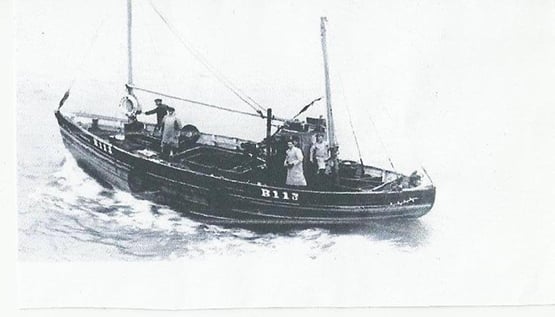 Aigh Vie in her final working days as a motorised fishing boat based at Ardglass
Aigh Vie in her final working days as a motorised fishing boat based at Ardglass
The deal was done, an ideal buy for a special man like Paddy Murphy, for the Aigh Vie is one very special vessel. The Manx fishing nobbies reached their ultimate state of development in the first twenty years of the 20th Century before steam power and then diesel engines took over. The nobby evolved to an almost yacht-like form through vessels like the 43ft White Heather (1904), which is owned and sailed under original-style dipping lug rig by Mike Clark in the Isle of Man, and the 1910 Vervine Blossom, now based in Kinvara, which was restored by Mick Hunt of Howth, but he gave her a more easily-handled gaff ketch rig which looked very well indeed when she sailed in the Vigo to Dublin Tall Ships Race in 1998.
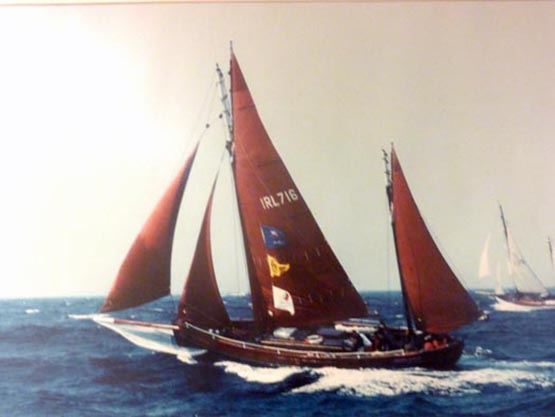
It was a sail on Mick Hunt’s 1910-built Manx nobby Vervine Blossom which inspired Paddy Murphy to go in pursuit of Aigh Vie
It takes quite something to outdo the provenance of these two fine vessels, but the story of Aigh Vie (it means a sort of mix of “good luck” and “fair winds” in Manx) is astonishing. It goes back to the sinking of the Lusitania by a German U Boat off the Cork coast in May 1915, when the first boat to mount a rescue was the Manx fishing ketch Wanderer from Peel, her crew of seven skippered by the 58-year-old William Ball.
They came upon a scene of developing carnage. Yet somehow, the little Wanderer managed to haul aboard and find space for 160 survivors, and provide them with succour and shelter as they made for port. In due course, as the enormity of the incident became clear, the achievement of the Wanderer’s crew was to be recognised with a special medal presentation. And then William Ball, who had been an employee of the Wanderer’s owner, received word that funds had been lodged with a lawyer in Peel on behalf of one of the American survivors he’d rescued. The money was to be used to underwrite the building of his own fishing boat, to be built in Peel to his personal specifications. The name of the donor has never been revealed, but the result was William Ball’s dreamship, the Aigh Vie, launched in December 1916 and first registered for fishing in January 1917.
Over the years, the Aigh Vie became a much-loved feature of the Irish Sea fishing fleet. Tim Magennis, former President of the Dublin Bay Old Gaffers Association, well remembers her from his boyhood days in the fishing port of Ardglass on the County Down coast. Her working days over, Billy Smyth gradually converted her to a Bermudan-rigged cruising ketch with a sheltering wheelhouse which enabled the Smyth family to make some notable cruises whatever the weather. His son Kenny Smyth, who now runs the boatyard with his brothers and is himself an ace helm in the local 29ft River Class, recalls that the seafaring Smyth family thought nothing of taking the Aigh Vie to the Orkneys at a time when the average Strangford Lough cruiser thought Tobermory the limit of reasonable ambitions.
After he’d bought the Aigh Vie and brought to her first base in Howth, Paddy Murphy soon realised he’d still a lot to learn about sailing and about keeping hard-worked old wooden boats in seafaring condition. But he’s such an entertaining and inspirational speaker that you’re swept along in his enthusiasm and empathise with his admission that, now and again, he felt things were getting on top of him.
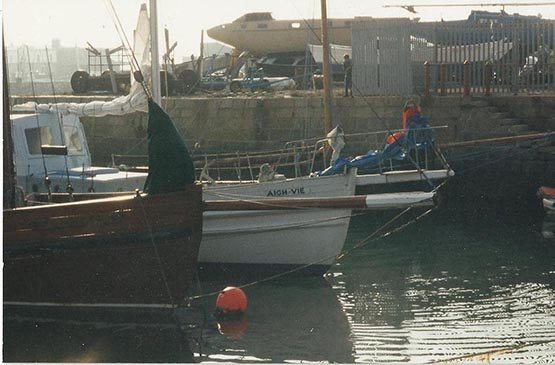
Sisters - Vervine Blossom (foreground) and Aigh Vie in Howth
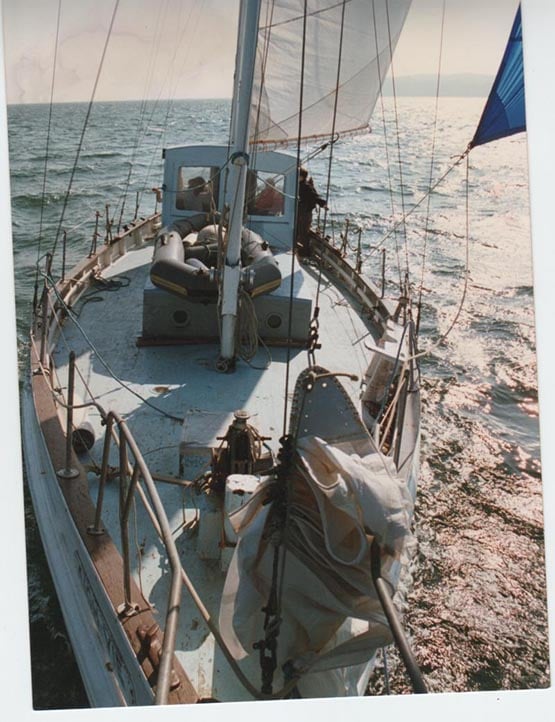
Sailing days on the Aigh Vie from Howth, before it was decided that she needed a major restoration
Following several seasons with increasing evidence of problems, he decided that a virtual re-build was necessary. It was then that the Dublin wooden boat owners’ perennial problem shot to the top of the agenda. In our very expensive city, the space and shelter to work long hours at an old wooden boats is almost impossible to come by, and he’d to shift the big Aigh Vie several times. On one occasion, he was asked to move in a hurry out of an ESB shed, but was offered £1,000 (this was pre-Euro days) to do so. He moved heaven and earth and finally found somewhere else at considerable expense, got the Aigh Vie installed there, and then went back to collect his thousand snots. Only to be laughed at. The manager told him it was the only way he could see to get the old boat moved out, but there were absolutely no funds available at all for such a thing, and surely Paddy would have guessed that?
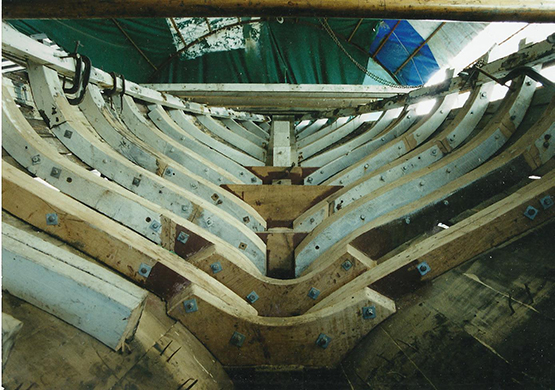
The re-building under way at Renvyle, using the technique where hull shape is retained by first replacing every other frame
With one thing and another, he moved to Renvyle in Connemara where he liked the big country and the open spaces and the friendly people right on the edge of the Atlantic, and in time Aigh Vie came too, and found herself being slowly re-born under a special roof. But it was demanding work for one man, so every so often a team led by Paul Keogh of the famous Galway Hooker from Clondalkin, the Naomh Cronan, together with a good selection of DBOGA specialist talent, descends on Renvyle to put in a ferocious day or two of work, and then on the Saturday night they put a fair bit of business the way of the pub at Tullycross.
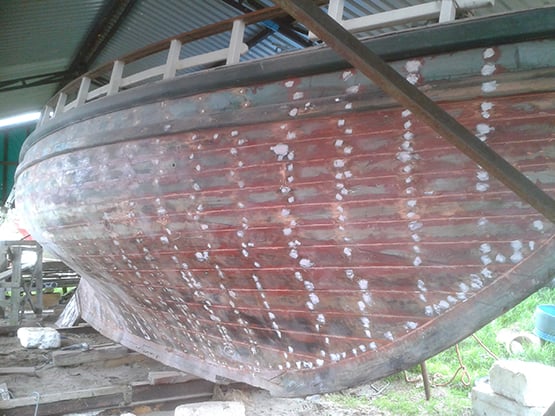
The planking was more easily restored by laying the Aigh Vie over on her side
Agh Vie upright again, and the deckhouses are being put in place
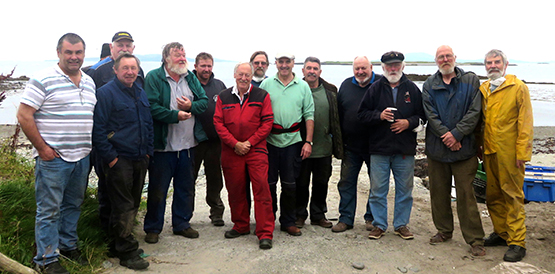
Old Gaffers Association International President Sean Walsh (right) and Peter Redmond install Aigh Vie’s new Perkins diesel. Photo: Cormac Lowth

One of the options for Aig Vie’s rig is the classic lug ketch as shown here with Mike Clark’s 1903-built White Heather
So now, many years later, the journey towards the restored Aigh Vie is getting near its destination. But it will never be fully ended. Thanks to sails, spars and rigs donated from other boats, Paddy has the choice of either gaff ketch or classic lug rig, so she’ll always be work in progress. Which is good news. Because every couple of years or so, the DBOGA can guarantee a full house to hear Paddy Murphy talking about how the Aigh Vie story is going.
He’s a wonderful speaker, sometimes almost messianic, and he shares his every feeling. Thus he mentioned that one day he was feeling a bit low, and he just went out to look at the big boat down by the shore, seeking some sort of inspiration. His mind had been elsewhere with the details of completing the interior, but he suddenly realised that he was at the stage of thinking of putting the white paint on the topsides. So he just set to with a big paint brush and a bigger tin of paint, and Aigh Vie was transformed. So was he. “That’s the secret” says he. “If you’re feeling a bit down, just go out and slap on some white paint. It works wonders.”

Feeling a bit down? Then just go out and slap a coat of white paint on the boat – it works wonders
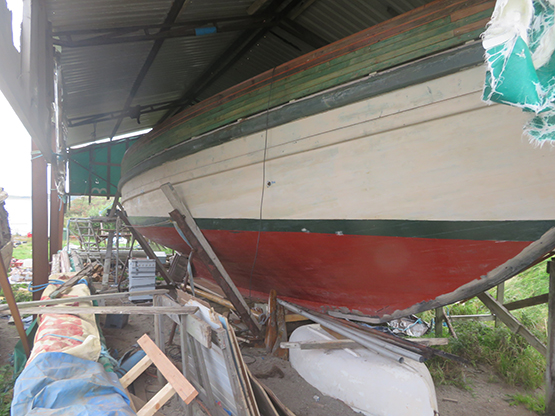
#boatswithcharacter – With the hope that boat numbers will start to increase again as we emerge from recession, categorisation resumes its central place in our thinking about the different types of craft we sail. Yet for a while, when the economy was at its nadir, you could classify your boat in almost any way you liked so long as you at least went out sailing, and kept fleet numbers at some sort of viable level.
But with things now on the move once more, some folk reckon they can afford to become a little more pernickety. For instance, the word is that the Old Gaffers Association may be going to insist that its racing awards can only be won by properly gaff-rigged boats. Yet when they were celebrating their Golden Jubilee in 2013 when the times were very thin indeed, some venerable but Bermudan-rigged craft were allowed to have a meaningful role. And if this was queried by some pedant, the official response was that they were actually setting gaff mainsails which just happened to be three-sided, and this was only as a temporary measure in response to the straitened times......
Quite so. But W M Nixon reckons that in the end, regardless of a boat's alleged type, it is character that is the final arbiter of quality both in the boats and their owners. In an exploration of this, he takes us on a virtual voyage from the Isle of Man to Achill Island, taking in some varied boat festivals on the way.
With boats as with people, it's character that counts. There are those of us who'd reckon there's more character in a battle-scarred all-plastic Cookson 50 than in a contemporary all-wood clinical re-creation of the design style of a previous era for what is known as "The Spirit of Classics" division. Though even here, the boats can begin to get some interesting character if they manage to get roughed about a bit - too much perfection is not good for the soul.
So give us a rough diamond any day, and in unusual boats, as with their owners, the waters around Ireland and nearby places have an abundance of them. One real diamond geezer is Joe Pennington from Ramsey in the Isle of Man. It always makes things that bit more right with the world when Joe comes into port with his workmanlike Manx longliner Master Frank, for Master Frank looks right, and is right – this is classic traditional, gold standard.
So it's ironic that although Joe is one of the Isle of Man's great sailing ambassadors, he's actually from north Lancashire. But he ended up working in the island as a carpenter, and failed to get off. The island, that is...As for his carpentry skills, they were up-graded to shipwright level, but he kept going as a carpenter as there was plenty of work around houses, while at same time restoring the Albert Strange yawl Emerald for his own use.
As he was based in Ramsey in the north of the island, he was very aware that it was the home port of the the last surviving Manx longliner, Master Frank built in 1895, the rapidly deteriorating example of an almost extinct species mouldering away in that very tidal harbour. People had realized the old boat's importance so much that the Manx government had been persuaded to buy her. But as with the Asgard in Ireland in the 1960s, the government may have bought her, but then they hadn't a clue what to do with her.
So one fine day, so the story goes, Joe in his working overalls marched into the Manx parliament, the House of Keys in Douglas, and berated the members for their neglect of this priceless example of the island's maritime heritage. They were flummoxed. So when he then offered to take on full responsibility for the Master Frank if they'd sell her to him with all rights for just one pound, they agreed, as enough was known about what he'd done with the Emerald to convince the assembly that this was their one last and best chance.
Restoring the Master Frank was in effect a re-build, and we have to remember that Joe was working fulltime in his day job as a carpenter. Yet he set himself a work schedule which gives you some idea of his depth of character. Many of us know Joe as a gregarious party animal. And as his appearance is something of a mixture between a gypsy king and the dangerous younger brother of a Roman Emperor, he certainly looks the part. But in order to bring the Master Frank back to life, he took the lonely route of coming home each evening after a day's work, having his tea, and then heading out that night for what was in effect another full day's work, but this time on the boat.

Most of us know Joe Pennington as a gregarious party animal, as seen here in the Peel S & CrC in the Isle of Man with Dickie Gomes of Ainmara and Stu Spence of Madcap.....Photo: W M Nixon
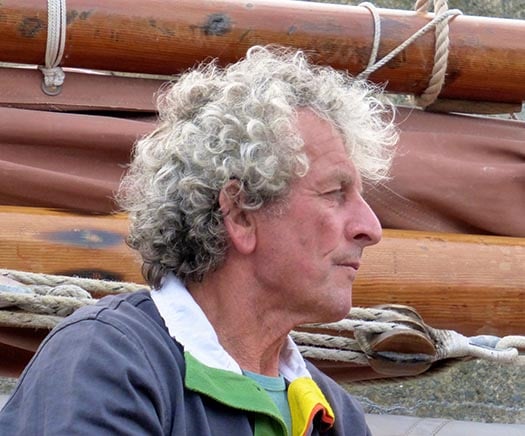
....but there's a serious and determined side to him, and he was just the man to save the very special Master Frank from extinction. Photo: W M Nixon
Night after night, week after week, the project went on, and when Master Frank was re-born, it was utterly worth the effort. Though she's only 36ft in overall hull length, she has the spirit of a much larger vessel, and her character is such that when she turns up at some assembly of classic and traditional craft, the event is a success even if only half a dozen other boats are taking part.
Just how much we'll see of her in Ireland this summer is in the lap of the Gods, as Joe likes to do a lot of cruising with his beloved boat, and Brittany calls. Master Frank is comfortable at sea, though like many workboats her actual hull freeboard is quite low – it's only the high bulwarks which seem to give her plenty of clearance.
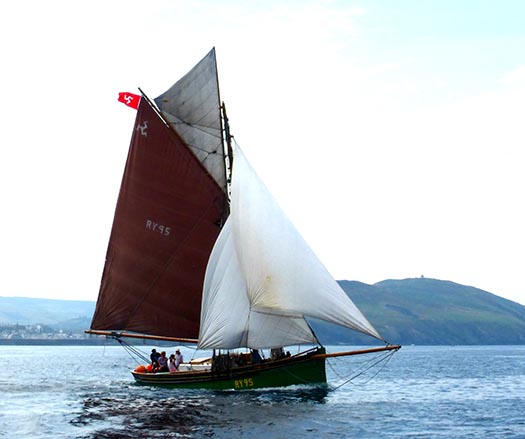
Even in this light breeze off Peel in the Isle of Man, the restored Master Frank shows her class. Photo: W M Nixon
Thus it's normal to have some water on deck when the going starts to get brisk, and this is a characteristic also seen on the famous former pilot cuter Jolie Brise. The noted photographer Brian Carlin captured this to perfection when Jolie Brise went out to the Fastnet Rock during the Glandore Classics in 2013, which happened to be the old pilot cutter's Centenary. She went round in style, but there was no lack of water on deck, and we are reminded of the designer Jack Laurent Giles' comments. After crewing offshore on Jolie Brise when he was still a trainee naval architect, his assertion was that in anything over Force 3 on Jolie Brise, you needed to wear your seaboots, but presumably you were otherwise perfectly comfortable until Force 8 or thereabouts.
 Low freeboard and heavy displacement mean water on deck, but the famous Jolie Brise is otherwise comfortable as she rounds the Fastet to celebrate her Centenary in 2013. Photo: Brian Carlin
Low freeboard and heavy displacement mean water on deck, but the famous Jolie Brise is otherwise comfortable as she rounds the Fastet to celebrate her Centenary in 2013. Photo: Brian Carlin
But while workboats like Jolie Brise and Master Frank needed low hull freeboard with high bulwarks to help them fulfill their allotted tasks, the hookers of Galway Bay were primarily people and cargo carriers, thus they have ample freeboard and are notably dry on deck. But as with the old longliner and the old pilot cutter, at crucial times in their histories the Galway Hookers have needed some determined characters working on their behalf to survive in any shape or form, and while their fleet numbers are now well up, there have been times when they seemed on the brink of extinction.
This was particularly the case in the 1960s. These days we know Dennis Aylmer of Dun Laoghaire as an ever-young senior sailor who relishes his time aboard his neat Cornish Crabber Mona. But the reality is that, more than most, Dennis has earned the right to relax with his "plastic fantastic". For in 1964 and 1965, having toured Connemara as a decidedly impecunious and very young man on his bicycle and then on a tiny motorbike searching for an authentic Galway hooker, he bought the big Morning Star at Tierna on Gorumna Island, and somehow found the resources to have her restored to basic seaworthiness, and then he brought her back to Dun Laoghaire.
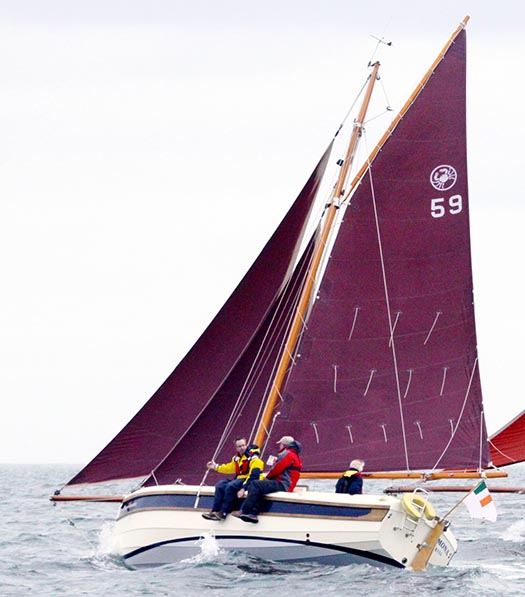
Traditional boat veteran Dennis Aylmer racing his very manageable Cornish Crabber Mona. Photo: Dave Owens
Though there were those who helped the young Aylmer in keeping the Morning Star going, in truth Dun Laoghaire in the 1960s was not a sympathetic environment for rough old gaff-rigged wooden craft. The Dublin Bay 21s had recently converted to Bermudan rig, and fibreglass was in the ascendant, with what amounted to the nucleus of a class of van de Stadt designed 36ft Excaliburs, which had a minimum of timber anywhere in their makeup.
And as work took her owner away for long periods, Morning Star's survival depended on the kindness of others. But somehow she stayed together one way or another until Johnny Healion took her over and gave her a mighty restoration for 1976 which, even on the shores of Galway Bay, was acknowledged as the initiative which led to a reversal in the decline of the old boats.
At one stage there was quite a fleet of restored Galway Hookers of all sizes in the Dublin area and along Ireland's East Coast, and they used to put in their most spectacular appearances at the Portaferry Traditional Boat Regatta in late June (this year's is 26th to 28th June 2015).
But two developments have seen the Galway Hookers' centre of gravity move very positively back to the west. The proliferation of marinas along the east coast is not bowsprit-friendly – old gaffers need a lot of pontoon length and ample manoeuvring space. And the M4 and the M6 have arrived. With Dublin coastal traffic being what it is, thanks to the motorway across Ireland to Galway, tradboat enthusiasts can get to gaffer Nirvanas like Kinvara almost as quickly as they can get to Dun Laoghaire or Howth, and they're more surely among kindred spirits when they get out west.
So although the most sacred gathering of the Galway Hookers is off Connemara at St MacDara's Island on the Saint's day, July 16th, the fleet of traditional boats around Galway Bay is really only up to full power with Cruinniu na mBad at Kinvara, which this year is August 14th to 16th.
The way that Kinvara's natural harbour is shaped, with the hospitable village and its quays at the head of a narrowing inlet which runs north and south to conveniently facilitate boats racing in the prevailing westerlies, means that this is one of the few places where sailing can comfortably become a spectator sport, and the badoiri revel in the close quarters challenges which Kinvara offers.
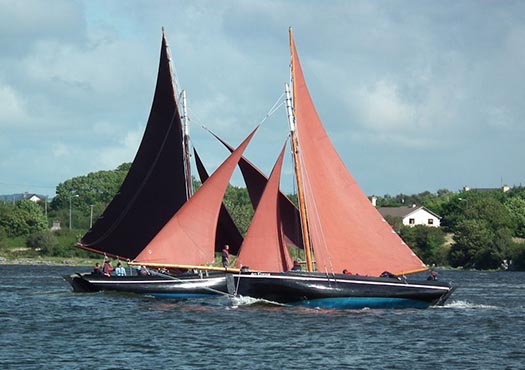
Close quarters Galway Hooker racing at its most visible – it can only be Kinvara.
However, the place becomes so crowded on the festival weekend that you might like to get your required ration of traditional boats elsewhere. But the problem is that while the sailors just want to get on with sailing among other like-minded souls on ancient craft, the organisers are usually in the numbers game, and they want to pack the pierheads and fill the vantage points with avid spectators.
It's all a long way from the long hours of solitary work which have gone into the maintenance of old boats, for which it's said the three essentials are a friend with a low-loader, a hayshed out the back of the house, and a very tolerant wife. Yet those are only the most basic requirements. When you see a gathering of traditional and classic boats in all their finery, what you're seeing is the coming together of people of real character who have had a dream, and they've stayed with it.
And if you're there at the local sea festival time, it will give you added insight into the neighbourhood. You'd be busy every summer weekend if you went with every sort of classic boat assembly, whether sailed, rowed or paddled, but if we just stick with the sailing, we find that there's a pattern which can indeed take us from the Isle of Man to Achill, and many places north and south of them as well.
They start early at Baltimore in West Cork, which could reasonably claim to be the headquarters of diversity in traditional craft, and this is celebrated from May 22nd to 24th this year with the Baltimore Wooden Boat Festival.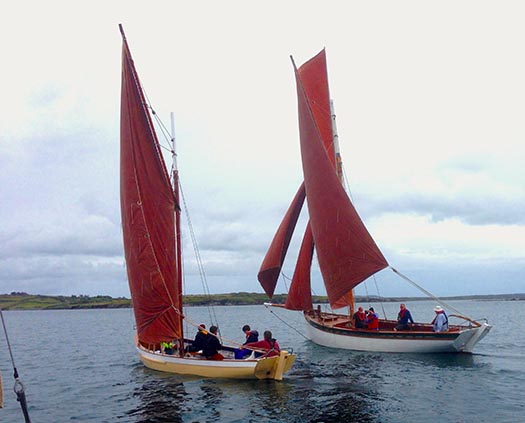
West Cork types will be much in evidence at the Baltimore Wooden Boat Festival from May 22nd to 24th. This is a classic mackerel yawl with a lobster yawl
Then the Dublin area is busy at the end of May and early June, with the DBOGA Riverfest from Poolbeg from May 30th to June 1st, while six days later, the long-established Lambay Race at Howth on June 6th now has a significant classic input with the 117-year-old jackyard topsail-setting Howth Seventeens being joined by both Old Gaffers and Classics.
Inevitably, choices have to be made as the season gains momentum, and the final weekend of June sees both the Portaferry gathering as already mentioned, and the Cobh Traditional Boat Festival on Cork Harbour from June 26th to 28th, with "traditional" naturally taken to include the 1895-vintage Fife-designed Cork Harbour One Designs.
The CHODs will also be starring in this year's main event, the Glandore Classics from July 18th to 24th. This shows every sign of being the biggest Glandore Classic Regatta ever, as the fleet will include a substantial number of Old Gaffers in the early stages of an OGA three week cruise-in-company from Kinsale to West Kerry, while the sailing will be something of a Fife Festival, as the CHODs will be sharing the same racing waters as the visiting Fife ODs from North Wales.
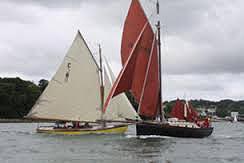
Cork Harbour One Design and Heard 28 Tir na nOg (Sean Walsh) managing to avoid each other at the Glandore Classic Regatta 2013.

Fife OD from the Menai Straits racing at Glandore Classics. Thanks to their wide side-decks, they can sail at an angle of heel unimaginable in most small keelboats, and some helmsmen reckon that the immersed lee deck provides useful lateral resistance
A notable feature of the North Wales Fifes is their wide side decks, which enable these pretty boats to heel a long way without taking water into the cockpit. In fact, it's said that some Fife helmsmen from the squally home waters of the Menai Straits reckon that if they heel their boat enough, the lee deck becomes a sort of secondary keel, and provides significant lateral resistance to enable them to continue to make to windward at an angle of heel which would have any other boat either sinking, or completely out of control, or just sliding sideways out of the picture altogether.......
Make of that what you will, but as we move on round the coast we find that currach racing becomes the dominant passion until the home waters of the Galway Hookers are reached, with the single exception of the one shining star, the Shannon Hooker Sally O'Keeffe at Kilrush, community-built at Querrin on the Loop Head Peninsula, and as sweet a little cutter as you'll see anywhere. Then on north, and we're into Galway Bay with each little port well filled with its quota of bad mor, leath bhad, gleiteog and pucaun.
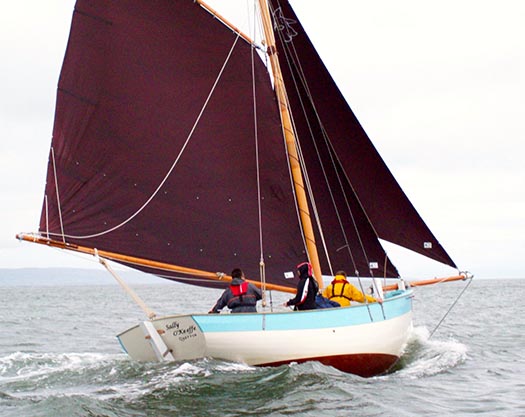
The sweetest thing in the west – the Shannon Hooker Sally O'Keeffe of Querrin on the Loop Head Peninsula
But what, you might well say, was all this about Achill Island? Well, there is a distinct species of local vessel in Achill Sound known as the Achill yawl which, with a single-sail lug rig which is almost a lateen, has a distant relationship to the classic Galway Bay pucaun.
But they have their own way of doing things in Achill Sound. At the peak of the boom years, every pub along the Sound, and local men who had done well in business abroad, between them supported a substantial fleet of Achill yawls which were raced in high summer and early Autumn with a ferocity which was astonishing even to sailmaker Des McWilliam of Crosshaven.
Heaven knows but Des has had enough experience of ferocious racing at all levels of the sport in all sorts of places. But when he went to far Mayo with a new set of threads for a keen Achill yawl owner, naturally as a diligent sailmaker he went afloat for a trial race, and came away suitably chastened by it all.
"We're just big pussy cats in Cork Harbour by comparison with Achill Sound" he reported. "In Achill racing" said he, "they take no prisoners". Yet even the hard men of Achill Sound had to ease back on their enthusiasms when the construction industry fell off a cliff. But just last September, crossing Achill Bridge, I spotted a bit of launching activity. It looks as though Achill yawl racing is showing signs of life again. But it won't be for the faint-hearted.
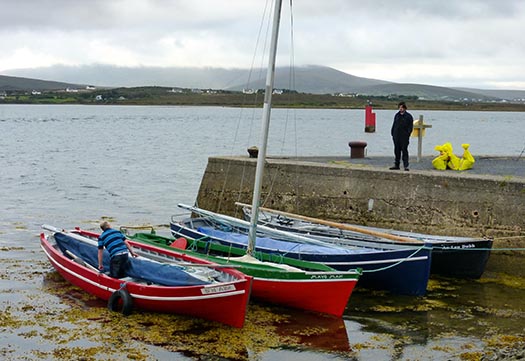
Achill yawls come in several shapes, and the most successful is not necessarily the fastest-looking. Photo: W M Nixon
Old Gaffers Plan West Cork Cruise Along The Fastnet Coast
#westcork – The Irish President of the Old Gaffers Association is organising a sailing cruise along the West Cork coast in July with venues to include well known harbours and landmarks along the 'Fastnet coast' such as Skellig Michael via Baltimore, Schull, Crookhaven, Castletownbere, and Adrigole.
In setting out plans for the cruise in company, an upbeat OGA chief Sean Walsh says West Cork caters for inclement weather by providing some of the 'best havens in the world', where 'enjoying creamy pints on a tall stool can be taken to a higher plane altogether, where good food, great craic and music abound'.
In issuing the invitation on the OGA website Walsh says, 'Where a Summer Cruise in Company (CIC) is concerned, guaranteeing anything can be a risky business. However, I feel reasonably safe in saying that participants in our OGA CIC, West Cork, will enjoy a warm Irish welcome, a myriad of stunningly beautiful and safe anchorages and havens, to match any in the world'.
The famous coastline featured recently on Afloat.ie when WM Nixon described the wonders of boating along the West Cork Coast.
The OGA Cruise in Company, West Cork is to muster in Kinsale on 17 July 2015. The next morning the OGA fleet sails to join the Classic Fleet in Glandore, for a week of racing, cruising and shoreside festivities. On 24 July, the fleet will head west again.
Do Boats Talk?
#islandnation – I have told my wife that my boat is not an inanimate object, that it does talk to me, which has generated the response that it costs enough, but does it ever explain why?
It may not be capable of vocal expression in terms of the delivery of a voice message, I have responded, but it certainly has an audio capability and a 'feel' to it, which lets me know when she (referring to my boat again) is unhappy with her situation, or the demands which I am making upon her.
When advancing this view to my wife in discussion, it has had less than a positive response and other people, perhaps not of a maritime vintage, do not accept my view that boats can talk, but I remain convinced that boats can and do talk in a particular manner. In the current edition of THIS ISLAND NATION which you can hear here, I am in discussion with Sean Walsh, President of the Old Gaffers' Association, about the love of boats and he tells me that he would not part with his beloved gaffer, Tir na nÓg of Howth.
"I sailed on a gaffer and I found the experience so extraordinary when I sailed on it for eleven years and then bought it and have sailed it for 22 years. My boat is a Falmouth Oyster and she is magnificent. These old gaffers were built for working fishermen and they fulfilled that brief perfectly in the same way as the Galway hookers fulfilled their brief," Sean told me when I interviewed him at one of those great locations for gatherings of the old gaffer, the Poolbeg Yacht and Boat Club in Ringsend, one of the great maritime locations of Dublin..
"Their sea kindliness, their ability, their composure in bad weather and a bad sea is, I found, totally extraordinary and I had never experienced anything like it and they look so bewitchingly beautiful in their full rig with a topsail and mainsail and I was bewitched when I first sailed on an old gaffer and I still am.
"I have been sailing Tir na nÓg of Howth for 22 years now and can never see myself sailing another boat."
There speaks a man who loves his boat.
Ah, if only old boats could talk, but there are sailors and owners, myself included, who believe that boats are not totally inanimate objects, but have a life and can, in their own way, talk to you at sea, letting you know how they feel as they cope with conditions.
What do you think – do boats talk?
John Hollahan accompanies the interview, singing 'If old Boats Could Talk'...
but perhaps they do, at least to some people..... me included.
The song is from the CD 'Songs for The River Men' which was compiled by the local community along the Suir Estuary when the three Bolger brothers, Paul, Kenny and Shane from Passage East in Co Waterford died after their 19ft fishing boat capsized outside Tramore Bay in June of last year. Paul, 49, was a father-of-one, his 44-year-old brother Shane had two young children and their 47-year-old brother Kenny was a single man.
On the programme you can also hear why tyres from a factory which closed down over 30 years ago are arriving on East Cork beaches and why the first-ever Christmas sea swim for charity, which started the tradition, will not be held this year.
The theme tune of THIS ISLAND NATION is 'Sailing By,' with which I led my maritime programme, SEASCAPES, on RTE for over 20 years. Now it sails on new airwaves. I hope you enjoy the programme.
Fair sailing
Ireland's Oldest Wooden Boats Aren't Getting Any Younger
#woodenboats – On Midsummer's Day, W M Nixon looks back on the already busy and event-filled Irish season of 2014, and reflects on the extraordinary longevity of some boats, their remarkable variety, and the diverse characters who own them.
When I shipped aboard the former Bristol Channel Pilot cutter Madcap to sail the Old Gaffers Division in Howth Yacht Club's Lambay Race on June 7th, it wasn't the first time I'd been out and about on a boat built in the 1870s. But as most of my experiences on John and Sandra Lefroy's 1873-vintage iron-built classic 58ft Victorian steam yacht Phoenix on Lough Derg took place in the 1970s with the most recent jaunt being way back in 1982, sailing on the Madcap was indeed the first time afloat in a boat built 140 years ago.
It takes an effort to get your head around the most basic notion of such an age. You find yourself reflecting on the delights that still awaited the human race at the time, things that were still far into the remote future in the 20th Century. During the 1870s, industrialisation was still gaining traction, but the very idea of warfare on the industrial scale which was to be experienced in the Great War of 1914-18 was beyond most people's imagination, and way beyond anyone's experience. That said, there were more than enough other ways of experiencing an early death, with a range of particularly unpleasant illnesses which have been largely eliminated today.
Yet it was increasing industrialisation which created the circumstances that enabled both boats to be built. The Bristol Channel Pilot cutters evolved rapidly in the latter half of the 19th Century in order to provide pilots for the more numerous and increasingly large ships which were coming into ports such as Cardiff and Bristol. They reached their peak of performance around 1900, by which time they'd achieved a remarkable stage of development, being fast and able, yet comfortable at sea, and capable of being handled by a very small crew after the pilots had been delivered to incoming vessels. When their working days were over as they were replaced by motorised vessels, they proved ideal as seagoing cruising yachts.
There was nothing work-oriented about the pleasure yacht Phoenix when she was built to the designs of Andrew Horn in Waterford in 1873. Or maybe that's being a bit naïve. After all, she is down as having been built by and for the Malcolmsons of Waterford. They were a remarkable clan who brought many industries to Waterford in the 19th Century, and they created the miniature industrial town of Portlaw westward from the city, off the south bank of the Suir Estuary.
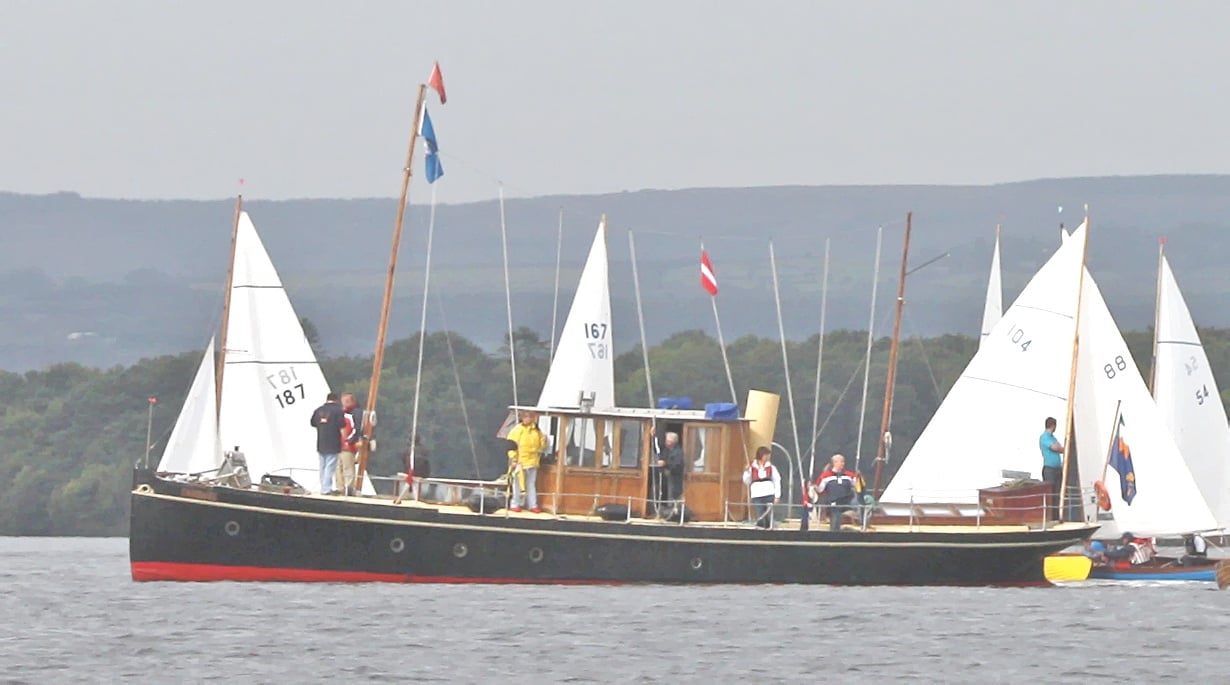
The 58ft Phoenix, iron-built in Waterford in 1873, performing Committee Boat duties at Dromineer for Lough Derg YC. Photo: Gerardine Wisdom
So in building the Phoenix themselves, so to speak, they were creating a subtle advertisement for Waterford expertise, with this new miniature of an ocean liner being constructed in the highly-regarded Lowmoor iron. And she's a powerful statement - this lovely old vessel has lasted much better than many of the Waterford enterprises which outshone her at the time of her building, so much so that if, in Waterford's current recessional woes, they sought something to symbolise what the city is capable of, they would do worse than put some resources the way of the Phoenix for her continuous maintenance.
Five years ago she made a very stylish appearance as the Committee Boat in a classics regatta at Dromineer, and that in turn produced an astonishing photo which included Ian Malcolm's 1898-built Howth 17 Aura. It was the first time a jackyard topsail had been seen on Lough Derg since before the Great War, and all that together with a raft of Shannon One Designs (which date from 1922 onwards) and a fleet of Dublin Bay Water Wags from 1902 onwards meant that the total age of the boat in the photo was pushing towards the 2,000 years mark.

Phoenix and the 1898 Howth 17 Aura (Ian Malcolm) at Dromineer with rafts of Shannon ODs and Water Wags. The combined age of the bots in the photo is well over a thousand years. Photo: Gerardine Wisdom
To be aboard Phoenix is to be transported right back to the 1870s, as she has a beam of only 10.5ft, which on a length of 58.5ft make for one very slim and potent hull. She has long since had her original steam engine replaced with a diesel, and back in 1982 when I was last afloat in her, it was October, and we were the Committee Boat for the annual IYA Helmsmans Championship, raced that year in Shannon One Designs with Dave Cummins of Sutton the winner, crewed by Gordon Maguire.
Being late season, the Phoenix's injectors needed a clean, but as the Race Officers were those perpetual schoolboys Jock Smith and Sam Dix of Malahide, they were delighted by the Phoenix's ability to emit a fine plume of smoke from her funnel at full speed, and after the championship was resolved they tore across the lively waters of Autumnal Lough Derg at full speed while – from another boat - I grabbed some photos which made Phoenix look like a destroyer in action at the Battle of Jutland. One of them subsequently appeared as the cover of Motor Boat & Yachting, and as I seem to have mislaid the colour slides, if anyone has a copy of that particular edition I'd much appreciate a scan of it.
Moving on from the 1873-built Phoenix in 1982 to the 1874-built Madcap in 2014 is quite some saga, but we'll edit it by sticking to events this year revolving around the developing annual Old Gaffer programme in the Irish Sea. Last year Dickie Gomes' 1912-built 36ft John B Kearney yawl Ainmara from Strangford Lough won the inaugural Leinster Trophy race in Dublin Bay which marked the OGA's Golden Jubilee, and she did it despite now being bermuda rigged. But as she was returning to her birthplace in Ringsend for the first time in 90 years, she was treated as an honorary gaffer.
Honour being the theme of things, this meant we were honour-bound to bring her south again to defend the Leinster in 2014, but this was given an added impetus by a plan to link up in Dun Laoghaire with Martin Birch's 1902-built Espanola out of Preston in Lancashire. From 1912 until 1940, the 47ft Espanola was a feature of the Royal Irish YC in Dun Laoghaire, owned by noted sailor Herbert Wright, who in 1929 became the founding Commodore of the Irish Cruising Club when he cruised Espanola with four other yachts to Glengarriff where the ICC was founded on July 13th 1929. The Espanola links, together with the fact that the RIYC is now in partnership with Wicklow Sailing Club in hosting the fleet for the biennial Round Ireland Race, made for a fortuitous combination, as Dickie Gomes of Ainmara was Mr Round Ireland between 1986 and 1993, when he held the open Round Ireland Record and also had been overall winner of the 1988 race.

Espanola as she was in 1929, when Commodore's yacht at the founding of the Irish Cruising Club
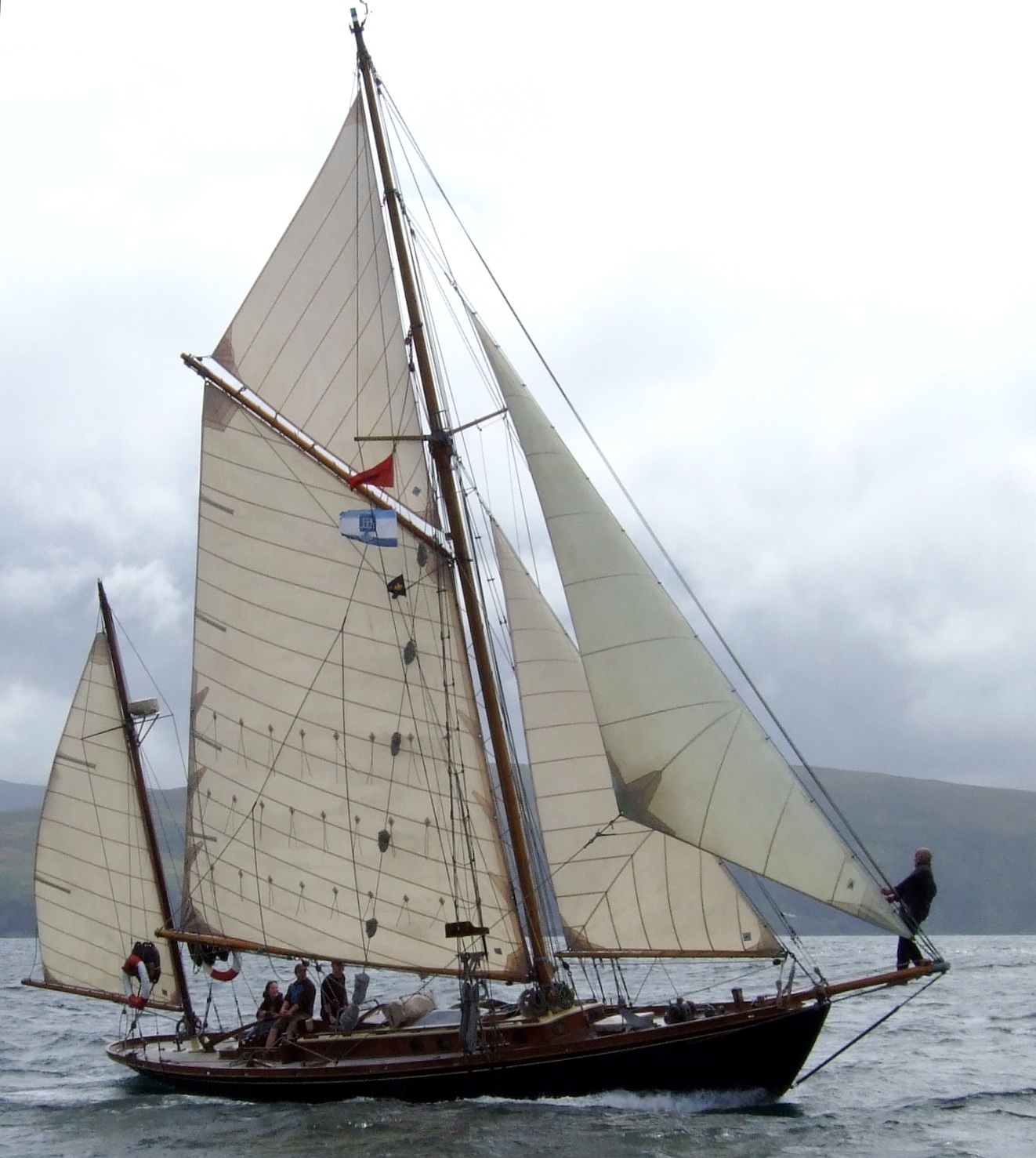
The 1902-built Espanola as she is today
Thus all the stars were in alignment for an historic and convivial meeting of the two old boats at the RIYC on the evening of Friday May 30th, the night before the Leinster Plate race was due to start just round the corner in Scotsmans Bay. But while stars may have been in alignment, ducks failed to get into a row, as Espanola with her exceptional draft of 7ft 6ins failed to get out of Preston over the shallow bar in the one tide which would have suited, on May 16th.
This situation is a useful illustration of the problems the old gaffer people face in keeping the show on the road with limited resources. Martin Birch, having been a lecturer in Lancaster University, had found Preston's little marina an ideal place to keep and maintain Espanola, and the marina in turn regarded the old girl as their pet boat. But Preston is longer a busy commercial port, so the channel has been left to is own devices, and with the huge tides of the Lancashire coast, getting Espanola to sea is quite a challenge as sometimes there's only one day in any month when it can be done.
So there we were, faced with the prospect of Hamlet without the Prince with just ten days to go to the historic gathering at the RIYC. But Jim Horan, affable Commodore of the Royal Irish YC, took it all in his stride and told us to bring Ainmara along anyway, it would be a good excuse for a Friday night party and he was keen to meet the skipper who had made the Round Ireland challenge very much his own 28 years ago.
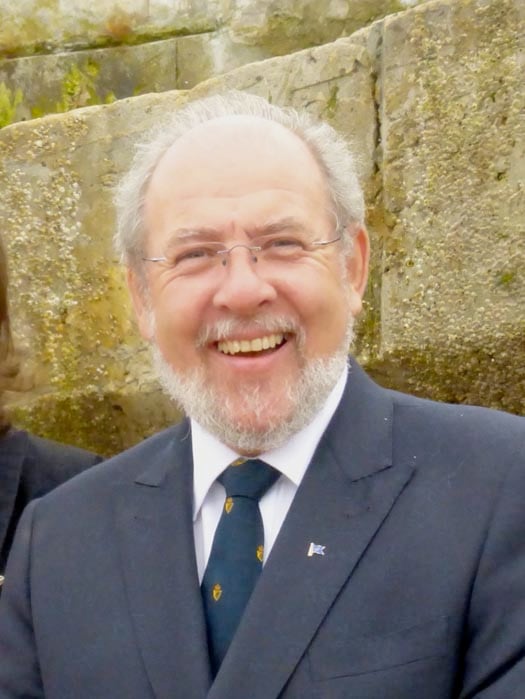
Jim Horan, Commodore of the RIYC, told us to come on and be welcome even though Espanola couldn't make it. Photo: W M Nixon
With the foul weather of mid-May, while Ainmara had got afloat from her winter quarters in a hayshed at the Gomes farm on the Ards peninsula in County Down, further fitting out was difficult in endless rain, and the skipper came down with a massive cold. But then the weather perked up, and he did too, so at lunchtime on Thursday My 29th we headed down Strangford Lough from the Down Cruising Club's former lightship headquarters at Ballydorn to catch the start of the ebb in Strangford Narrows at 1430 hrs.
Progress was good with a light to moderate nor'easter, but Ainmara and her crew (there were four of us – Brian Law, Ed Wheeler and I together with Dickie) have got to the stage where nights at sea are regarded to be the result of bad cruise planning. Yet if we were going to be comfortably in Dun Laoghaire for Friday evening, then only Port Oriel at Clogherhead made sense as an overnight. But Port Oriel, home to some of the best-maintained fishing boats on the coast, can become a very crowded place on a Thursday night.
However, a phone call to the uncrowned king of Clogherhead Aidan Sharkey – whom I'd first met back in the 1980s when our two boats were moored in Seal Hole at Lambay, where he was diving on the nearby 1854 wreck of the Tayleur - ensured there'd be a berth for us, and when we arrived in at sunset there was the man himself to direct us to a corner where we wouldn't inconvenience fishing boats, and moreover had access to a set of proper steps.
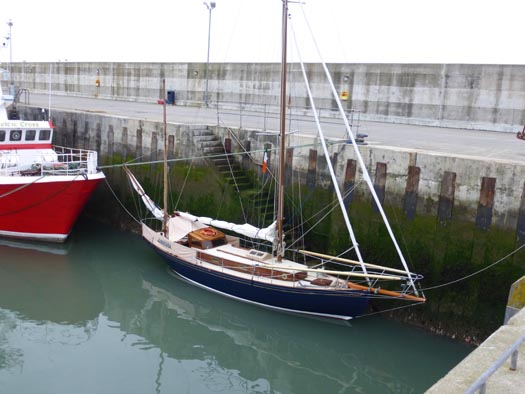
Port Oriel at Clogherhead provided Ainmara wih a handy overnight stop. There was more space available (below) as most of the 30-strong local fleet were away fishing the south coast. Photos: W M Nixon

Aidan's commitment to the maritime life is total. He's of an old Clogherhead fishing family, and he and his late brother Feargal were the backbone of the local beach-launched lifeboat crew. The banter was mighty on board Ainmara, leavened with tales of lifeboat experience which would curl your hair. The laughter through the companionway attracted others board, and soon Sean the razor clam man (all of his catches go straight to China) was in the hatchway with glass in hand, and when we asked where we might get a new deck scrub first thing in the morning as somehow the ship's own one had gone AWOL, Sean said not to worry, he'd throw one on board, and we could just leave it on the big fishing boat beside us as we left next day.
Ashore, I went up to Aidan's house in the village as he'd said he'd something to show me, which was an understatement. He was into the diving much earlier than most, thus when he got to wrecks which today are known to everyone, there were still intact bits of the cargo to be salvaged. Most east coast divers have fragments of chinaware, pottery and other artefacts from the Tayleur, but Sean had so many complete pieces, together with many other items of special antique value from other wrecks mostly in Donegal, that he would be well able to provide complete afternoon tea for the entire choir, all served on 1840s china. But it wasn't tea I got in the Sharkey household, it was Aidan's present of a large bag of fresh crab claws, and a selection of his own-cured salmon – smoked and gravid lax both – which sustained us through the next day's sail.
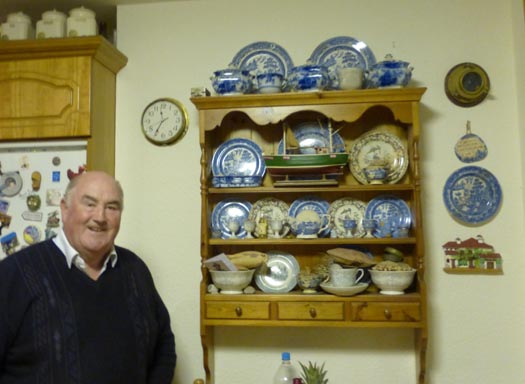
Aidan Sharkey of Clogherhead with some of his remarkable collection of salvaged chinaware. Photo: W M Nixon

The sort of sailing cruising folk dream of. Ainmara shaping up nicely to take the first of the fair tide through the islands at Skerries. Photo: W M Nixon
The morning brought the welcome gift of a decent little sunny east to nor'east breeze, and a lovely beam reach all the way down to Dublin Bay, with the south-going tide caught to perfection at the Skerries islands (and yes, I know it's superfluous to talk of the "Skerries islands", but that's what they're called to differentiate them from the Skerries off Holyhead).
Anyone who was involved in last weekend's ICRA Nationals at the Royal Irish YC will know how this premier club can lay on the welcome with effortless style. In the last weekend of May, Ainmara and her crew had the Royal Irish treatment all to themselves. Sailing Manager Mark McGibney ushered us to the prime berth right at the club where we found ourselves in a miniature maritime museum, with the Quarter Tonner Quest close astern (she was to become the ICRA National Champion a fortnight later), while just across the way was the S&S 36 Sarnia – back in 1966, the Sisk family set Irish sailing alight by bringing this very up-to-the-minute fin-and-skeg fibreglass boat back from builders Cantiere Benello in Italy, where they'd started series production on this ground-breaking Olin Stephens design before the same hull shape became better known as the Swan 36 built by Nautor in Finland.
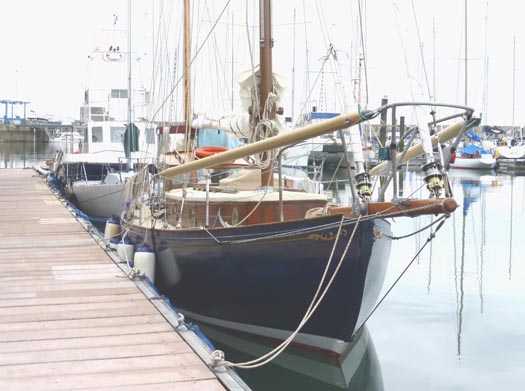
"Maritime museum" at the Royal Irish YC. Ainmara (built Ringsend 1912) with the 1987 Quarter Tonner Quest astern, and the 1966-built S&S 36 Sarnia across the way in her marina berth. Photo: W M Nixon
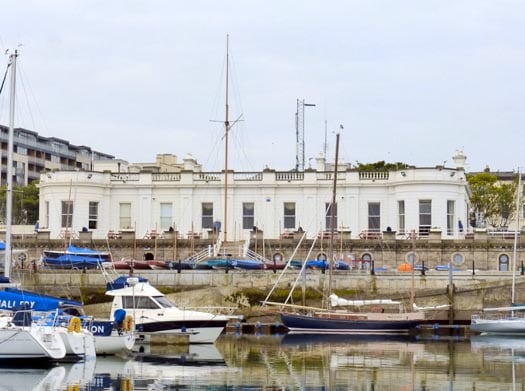
It has to be one of the best berths in the world. Ainmara at the RIYC – it's early morning, and the flags aren't yet hoisted. Photo: W M Nixon
The hospitality flowed seamlessly as the late afternoon graduated into evening and then velvet night. Ainmara is an extraordinarily effective calling card, and the stream of entertaining visitors brought laughter aboard before the Commodore moved us all up to the clubhouse and a fine supper and much chat with Michael O'Leary, one of the most visionary minds in Irish sailing, and his wife Kate and her people with tales of how she and longtime friend Clare Hogan are in the thick of things in the very healthy Water Wag class.
The RIYC took all this in its stride despite the fact that there was a big wedding going in the clubhouse at the same time, but it all went so smoothly that at one stage Ainmara's crew found themselves being invited to join in the wedding celebrations. However, we demurred because we were athletes in training for the Leinster Trophy next day, yet nevertheless certain key players in the wedding got themselves aboard Ainmara at a very late hour.
The plan for Saturday had been changed, but we were right up to speed with this as Denis Aylmer, the RIYC's key man in the OGA, had told us over a convivial pint that the likelihood of light winds had meant that Race Officer John Alvey had moved the scene of the action from Scotsmans Bay to a more compact race area close off the entrance to Dublin Port. It was all grist to our mill, as we could make an early morning departure and head up to Poolbeg Y & BC across a mirror-like bay, lining up the crew to salute the North Bank Lighthouse in the River Liffey, as it's something of a memorial to John B Kearney, whose day job was in the engineering department in Dublin Port and docks. With his original lighthouse, he pioneering a technique of screwing the piles into the seabed. You'd have thought an air of reverence would prevail, but with Ainmara's crew of anarchists, straight faces could only be maintained for about 12 seconds.
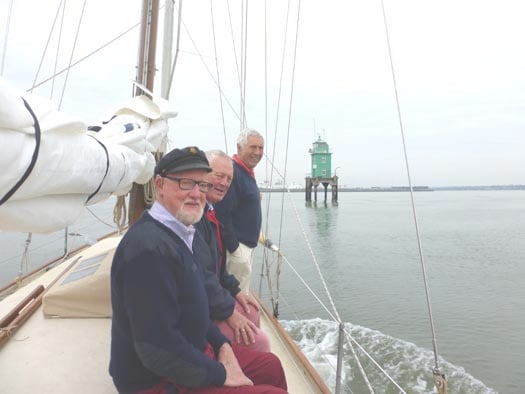
Trying to look appropriately reverential. Ed Wheeler, Brian Law and Dickie Gomes approaching Dublin Port's North Bank Lighthouse on which John B Kearney pioneered the use of screw piles. Photo: W M Nixon

"We're only here for the breakfast". Katy O'Connor's excellent catering in Poolbeg Y & BC is deservedly popular among visiting crews. Photo: W M Nixon
While we wanted to be well on time for the pre-race briefing, the main reason for getting promptly to Poolbeg was to take full advantage of Katy O'Connor's legendary breakfast at the club, and we put away enough calories to keep us going all day. At the briefing, John Alvey told us the committee were concerned that the very varied fleet – everything from Ainmara to the big Naomh Cronan, a superb Clondalkin-built re-creation of a Galway Hooker – included some boats which, in the light airs expected, could be out on the bay until nightfall.
So the plan was for a short race taking in several marks so that it could be finished at the end of any leg. But by the time we got down to Dublin Bay, it was crisp blue with a smart little sea breeze filling in to give sailing conditions which suited Ainmara to perfection, yet some of the heavier gaffers were still lumbering slowly about in what to them was a light wind.
They may have been lumbering about, but several were very determined to make a sharp start right on the committee boat. Anyone accustomed to quick-turning and fast-accelerating modern boats will find a fleet of traditional and classic gaffers a real education. They take time to get moving, they take for ever to stop, you point them a long way out, and their bowsprits – "dock probes" as marina managers call them – seem intent on skewering everyone else.
But while our skipper may pretend to be just an old cruising man these days, his racing blood was up. We set ourselves to sweep into what we hoped would be a gap starting to appear at the committee boat seconds after the start signal. We consoled ourselves with the thought that in extremis, we might just manage to shoot head to wind leaving the committee boat to port, ruining our start perhaps, but preserving the Ainmara intact.
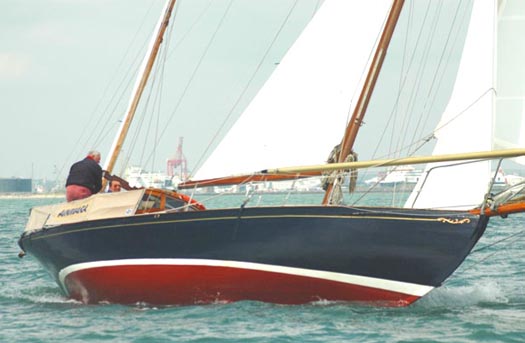
"Go for it, and let's hope there's a gap when we get there..." Ainmara starts to build speed towards her start in the Leinster Trophy Race 2014 . Photo: Gill Mills
So she was set at it, despite attempts to slow her a bit the speed built up, but as quickly as I'm telling this the gap started to appear and she zapped into it and just managed to keep her wind clear on Sean Walsh's remarkably fast Heard 28 Tir na nOg and Denis Aylmer's Mona. Now we had to find the DBSC marks in the right sequence, but Ed was on top of it feeding co-ordinates and giving out courses, we found that with a bit of luck we might just lay the first mark close hauled, and though Tir na nOg – whose waterline length is much the same as Ainmara's – hung in very well, he'd to tack for the mark while we scraped by it, so after that it was up jib tops'l and making hay.
But though we took line honours, we felt certain Tir na nOg would win on corrected time, as a Heard 28 sailed as well as she is can be one very potent performer, and Sean seemd to be still right on our stern at the finish. The results wouldn't be announced until Monday evening, so that Saturday afternoon we wandered back upriver to Poolbeg in sunshine so powerful that an afternoon zizz was your only man, and then we emerged on deck to find that others were arriving in port, with one of the the Welsh visitors, the engine-less Happy Quest from Milford Haven, making a copy-book job of berthing under sail, and then all was alive with the Howth Seventeens arriving in from their home port after a very close-fought passage race which had been narrowly won by Conor Turvey sailing Isobel.

Happy Quest from southwest Wales lives up to her name with a successful berthing under sail only at Poolbeg. Photo: W M Nixon
The Seventeens were there to put on a display race next day (Sunday) in the Liffey as part of the three day Dublin Port Riverfest over the Bank Holiday weekend. Inevitably for those of us who took part in the first one in 2013 when the OGA Golden Jubilee was top of the bill, there wasn't quite the same buzz, but first-timers watching aboard the restaurant ship Cill Airne assured us they found it very exciting indeed, and were especially impressed by the waterborne ballet of the two big harbour tugs Shackleton and Beaufort, while the funfairs and entertainment shows along the quays really did provide something for everything.
Once again the very sight of the Seventeens – which we in Howth tend to take for granted – was fascinating in the city setting. Though the promise of a decent breeze evaporated, Race Officer Harry Gallagher managed to get enough in the way of results to declare Peter Courtney with Oonagh the winner, an appropriate result for an historic class making a show performance, as the Courtneys have been involved with the Howth Seventeens since 1907.
I watched it all from an appropriate setting, aboard the Dutch Tall Ship Morgenster, a handsome 150ft brig which should be required visiting for anyone promoting the idea of a new Tall Ship for Ireland. For the Morgenster – which was re-configured as a sailing ship in 2009 – is run as a commercial venture, and can pay her way through being the right size to be a business proposition, helped by being based in the Netherlands. Thus she has a vast continental catchment area nearby to attract trainees of all ages and abilities who are prepared to pay enough for berths to keep the show efficiently on the road. There are several Dutch-based tall ships run in the same way, and the message is that if you're going to make a go of it commercially, you have to have a large enough and readily-accessed market to make it viable, and you need a boat big enough to carry sufficient trainees relative to the size of the ship – 36 in Morgenster's case – to balance the books.
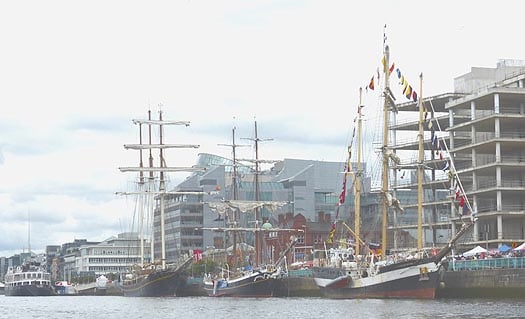
Tall ships in the Liffey, with the commercially-run 150ft sail training big Morgenster at centre. Photo: W M Nixon
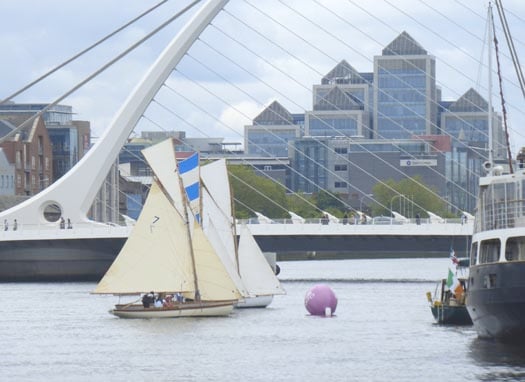
Sails and the city – Howth 17s at the Sam Beckett bridge Photo: W M Nixon
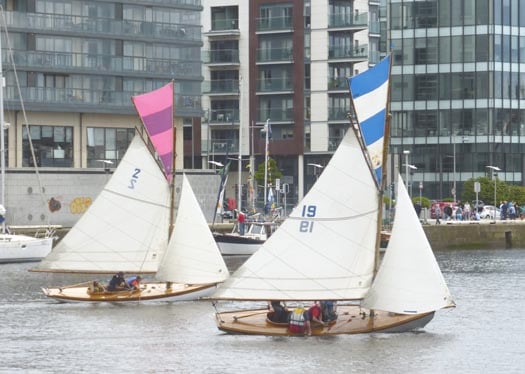
There was just enough wind for the first race for the Howth 17s to show what they could do in the Liffey if the breeze held up. Photo: W M Nixon
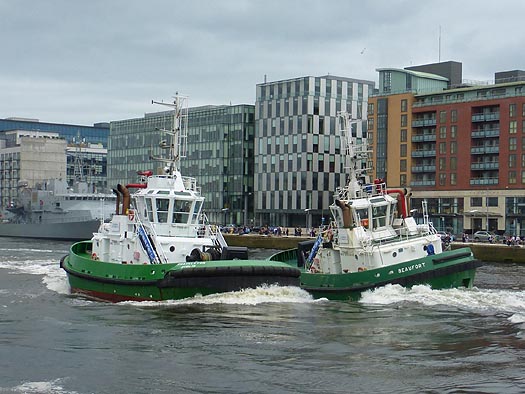
The Dublin Port tugs have awesome power to deploy in their waterborne "ballet" Photo: W M Nixon
But enough of solemnity. We went downriver again for farewells at Poolbeg, and then away across Dublin Bay and round the Baily for a seafood feast in Howth at the new place Crabby Jo's, and a handy overnight stop before using a good westerly next morning to give us a push towards Ardglass where we needs must stop, as the tides into Strangford Lough are a door slammed shut every six hours. But as ever, Ardglass's convenient and friendly little marina provided the perfect decompression chamber, and up in Mulherron's the crack was mighty with the crew of the famous restored Manx longliner Master Frank, just the two of them with skipper Joe Pennington - aka The Rat – being crewed by a psychiatrist who claimed to be strictly on holiday, but we did wonder, as any gathering of Old Gaffers is better than a wardful of nutters.
Ainmara's mini-voyage concluded next day with a text message from Dublin to tell us we'd retained the Leinster Trophy, which surprised us, and then with an idyllic sail in a sunny sou'wester, everything set to the jib tops'l, and all sail carried right through The Narrows, across Strangford Lough and thorough Ringhaddy Sound, and on across a blue sea among green islands past tree covered shores until we handed the sails just off the entrance to Down Cruising Club's isle-girt outer anchorage immediately south of Mahee Island, in a little sheltered area which has somehow acquired the unlovely name of Pongo Bay.

Home again. Ainmara back on her mooring in Strangford Lough, with Brian Law's classic yawl Twilight astern. Photo: W M Nixon
There, Ainmara is securely moored close to Brian Law's own cruising boat, the beautifully restored classic Lion Class yawl Twilight, designed by Arthur Robb. Like Dickie Gomes, Brian does all his own boatwork in a hayshed beside the house. So closely intertwined are their interests that they readily crew for each other, and of course the exchange of information and assistance and re-fit ideas is continuous.
And there's one further fact about these guys which may be of interest to other cruising crews. Aboard Ainmara during the three seasons in which I've cruised on her since she was restored for her Centenary in 1912, there's no kitty to cover expenses. There's an underlying feeling that as the skipper provides the boat, the crew owe him on a permanent basis. Thus if we get into a port and there's a choice between a comfortable marina berth or hanging off a quay wall, the crew will simply slip away and discreetly pay for a marina berth, and then tell the skipper it's a done deal.
Equally, when ashore for a meal, one of the crew will usually sidle off and pay for everyone when no-one else is looking. But if the skipper thinks the day has gone particularly well, you'll sometimes find he's paid for it all himself, As for getting diesel, whoever is carrying the cans will pay for it himself. Then too, when stores are required, it's covered by whoever goes to get them. It all sounds like an accountant's nightmare, yet so far, somehow at the end of the cruise everyone is content with the feeling that it has all balanced out, and as it has worked well for three years and longer, the attitude is that if it ain't broke, then don't try and fix it.
It had been hoped that Ainmara could stay on in the Dublin area for a week to do the Howth YC's Lambay Race in the Old Gaffers division on June 7th, as she won it in 1921. However, there was too much work still to be done to get her completely ready for a busy cruise programme coming rapidly down the line. But as she'll have to be back next year to defend the Leinster Trophy again, who knows but the double event might be done in 2015. As it was, her need for further fitting-out nearer to home was the saving of me, as a mighy temptation arose. The ancient Madcap from the north had stayed on in Dublin Bay, and was doing the Lambay Race with other old gaffers. The word on the waterfront is that Madcap may well be sold to France to be the centrepiece of a maritime museum in La Rochelle. So the Lambay Race might well be the last chance to sail on a 140-year-old boat. A place was secured on board.

The gaffers gather......Tir na nOg, Madcap and Naomh Cronan on misty morning in Howth before the Lambay Race. Photo: W M Nixon
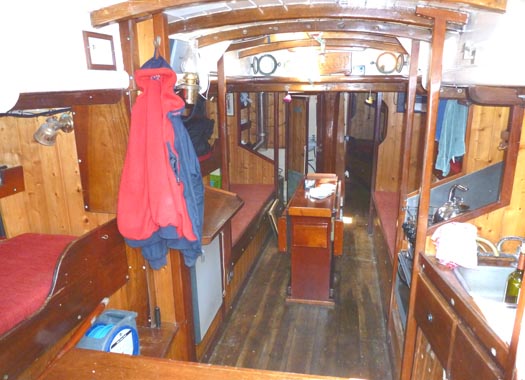
Madcap's sensible accommodation (above and below) reflects the seagoing needs of the pilots for whom she was built140 years ago. Photo: W M Nixon
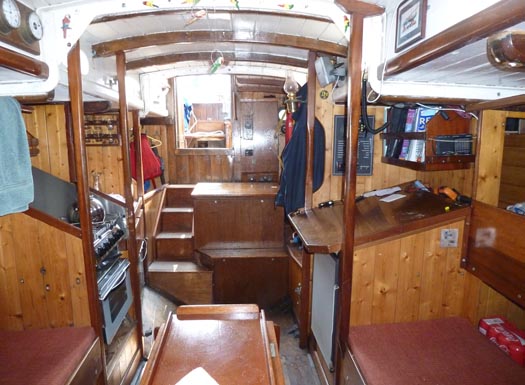
Madcap's owner for more than twenty years now has been Adrian "Stu" Spence, a rugged Belfast barrister who has the essential determination to keep such an ancient boat going. And going places too – he has been to Greenland and several times to Spain and Brittany, and has brought his old cutter through many a problem to log an impressive voyaging record.
If you have a boat of this age, your motto is: When God made time, he made a lot of it. Thus although the Old Gaffer's division was due to start at 1135, five minutes after the Howth Seventeens had set off through Howth Sound to sail the traditional Lambay course leaving Ireland's Eye to starboard and Lambay to port in order to celebrate the centenary of the Lynch family's Howth 17 Echo, it was pushing 1140 by the time we mde our leisurely debut to follow other other gaffers, which had Sean Walsh's keenly-sailed Tir na nOg soon disappearing into the misty asterly, followed by the Galway hooker Naomh Cronan helmed by the great Paddy Murphy of Renvyle, the Cornish crabber Alice (Mark Lynch) and then Madcp in her own good time.
With Northern Ireland Old Gaffers Association President Peter Chambers on the helm, Madcap settled gently into her stride, showing that she needs very little steering – she'll maintain a straight line for miles without the wheel being touched or secured in a any way. It's an oddly soothing characteristic, just the thing to calm a man down after a hectic week in the High Court, and she soon was making her own best speed with a bit of bite now in the breeze, putting Alice astern and keeping Naomh Cronan handily in touch.

"Is it always this foggy off Howth?" Stu Spence and Peter Chambers with he visibility closing in during the Lambay Race. Photo: W M Nixon
The mist became fog, but as ever it was difficult to tell just how thick it was until we suddenly found ourselves surrounded by wraiths in the gloom. It was Class 0 racing towards Lambay, and overtaking us just feet away, giving dramatic close-ups of some of the most likeable boats on the East Coast, with Stephen O'Flaherty's Spirit 54 Soufriere pacing it with Chris Hourican's First 47.7 Pretty Polly and the Tyrrell family from Arklow with their handsome J/122 Aquelina.
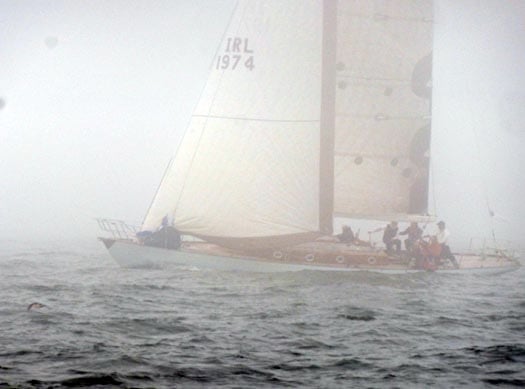
Do not adjust your sets, it really was this foggy for a while. Stephen O'Flaherty's Spirit 54 Soufriere in the fog during the Lambay Race Photo: W M Nixon

Chris Hourican's First 47.7 Pretty Polly in close-up Photo: W M Nixon
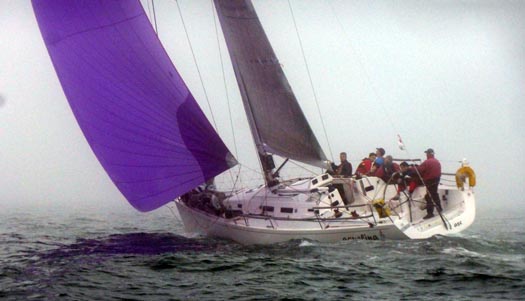
The Tyrrell family's J/122 Aquelina looking her best as she slices through the fog. Photo: W M Nixon
The fog was lifting as we got to the island with boats everywhere – the gaffermen were most impressed. Naomh Croanan had been overtaken, and Peter found us the perfect track along the flukey north side of Lambay, with Madcap effortlessly sliding over the smooth sea on a dead run and apparently consolidating her position.
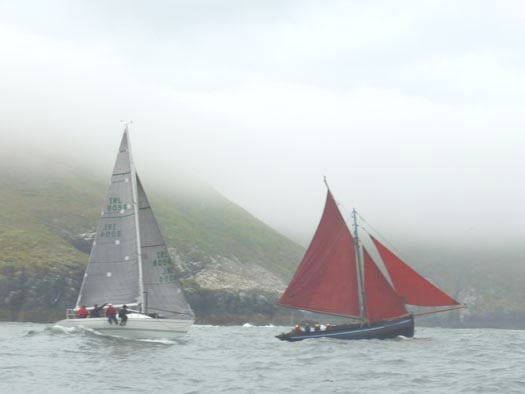
The fog start to lift. Dave Cullen's Half Tonner King One and te Naomh Cronan pproaching the east point of Lambay. Photo: W M Nixon
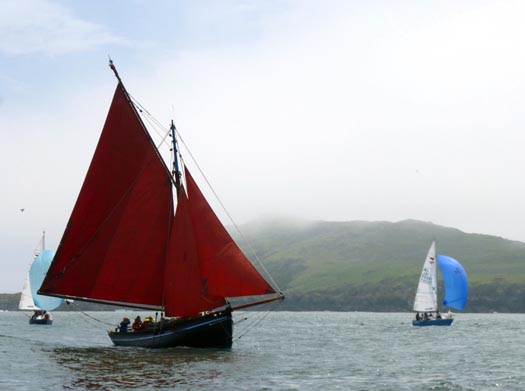
It could be Connemara...., .Naomh Cronan and two Puppeteer 22s off the north coast of Lambay Photo: W M Nixon

The long haul to the finish, the sun is out, and the breeze is beginning to develop enough power to suit Madcap. Photo: W M Nixon
But that was only until we started to head south back to the finish in Howth Sound. The Bermudan boats could lay it, so could the Seventeens, but poor old Madcap was even outpointed by Naomh Cronan, which Paddy Murphy very skilfully kept inside the line of foul tide in Lambay Sound and began to nibble at our lead, while we sagged to lee.
The sun was out, the sailing was lovely, we were surrounded by bustling classes of Puppeteer 22s and Ruffians 23s, and I suggested that a bit more tension in the jib luff, might do the trick, only to be told that as the bowsprit was no more than a liberated telegraph pole, it wasn't really up to the loads which would be put on it by trying to maximise the performance of a 22-ton boat, and nobody wanted splinters flying every which way aboard a boat where the mainboom looked to weigh at least half a ton.
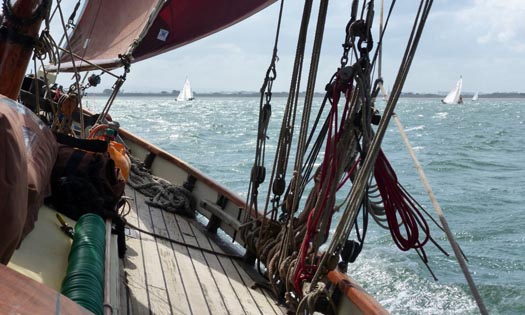
A bite to the breeze, with little boats everywhere – and all of them on starboard. Photo: W M Nixon

The Dun Laoghaire Ruffian 23s made a weekend of it for the Lambay Race, coming over on the Friday night, partying mightily, and then going out to race on Saturday in a rising breeze. Photo: W M Nixon
As it is the loads becme quite something as the breeze freshened sunny and squally down the north flank of the hjill of Howth. By the time we made it across the line, Madcap was going well on smooth water under just mainsail and staysail. But though Naomh Cronan was still ahead and rightly delighted with themselves at getting a good second, it was Tir na nOg which had been in race of her own. Yet as Sean Walsh reported with astonishment, he hadn't been able to get among the slippy little Howth 17s, where John Curley and Marcus Lynch had a good win with Rita, Howth Seventeen No. 1.
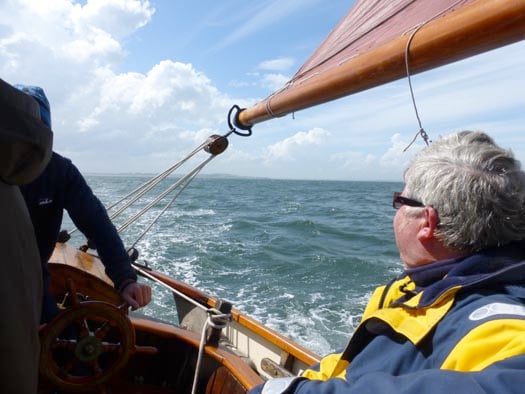
Finally there was enough breeze for Madcap's wake to stretch satisfyingly astern while she could point better with the jib brought in, but Naomh Cronan still finished ahead to take second prize. Photo: W M Nixon

The mighty helmsman of Renvyle. Paddy Murphy (left) steered Naomh Cronan to an excellent performance in the Lambay Race 2014. With him is DBOGA Hon Sec Gerry Murtagh with a trophy he won racing round Lambay in 1986. Photo: W M Nixon
It seemed an Old Gaffers Classic Lambay Race had been inaugurated, and Sean Walsh, international President of the OGA, was most appropriately the first winner. It was something to celebrate, and it duly was, in the sunshine at Howth YC. But in time, I had to take myself away and go for a long walk with the little dog along the beach. For when you've been sailing on a 140-year-old boat, there's a need to ponder the passing years, and this crazy sport of ours in which museum pieces are part of the action.
Irish President for the Old Gaffers Association
#oga – For the first time in its 50 years, the Old Gaffers Association has an Irish President. W M Nixon profiles Sean Walsh as he begins a three year term heading up this increasingly international organisation, which raised its profile with 2013's Golden Jubilee celebrations including major events for classic and traditional craft in Dublin, Belfast, and Peel in the Isle of Man.
If you were putting together the dream profile of an ideal person to become the first Irish President of the Old Gaffers Association as that somewhat quirky organisation quietly flexes its muscles on completion of the successful celebration of its Golden Jubilee in 2013, then you'd come up with somebody very like Sean Walsh.
In London last Saturday, he was elected to a three-year term as President of the OGA. In its fifty years, the Association has grown from being an informal organisation based around the Thames Estuary and the Solent into an international body with branches throughout the UK and Ireland, in addition to groups in the Netherlands, Belgium, France, British Columbia, Australia and New Zealand. Yet despite this steady and widespread growth, Sean Walsh, the eleventh President, is not only the first incumbent from overseas, but he's the first one from outside the southeastern half of England.
His fascination with gaff rig and classic design based on proven working boat principles, coupled with his warm enjoyment of the fellowship of the sea, would be impressive qualifications in themselves. But this is combined with high technical ability in boats and their equipment, both ancient and modern. And it's allied to a life experience which has given him the outlook and social skills needed to fulfill a role for which there are few textbooks and precedents.
For sure, there have been, and still are, Irish sailing administrators in major international organisations which are central to mainstream sailing. As a nation, we have punched way above our weight in top roles in the global organisation now known as the International Sailing Federation. And Dun Laoghaire's John Bourke gave unstinting service both as Commodore of the Royal Ocean Racing Club from 1994-1996, and as Chairman of the Offshore Racing Council, while the RORC has also seen major input from Cork with the late Denis Doyle as a Flag Officer, a role recently filled by Anthony O'Leary while Dun Laoghaire is currently rising in the officer ranks again with Michael Boyd (RIYC) now serving as RORC Vice Commodore.
But the Old Gaffers Association is different. In fact, being different is what it's all about. In some ways, you could say it's the sailing organisation which provides a home for boat enthusiasts who don't feel comfortable anywhere else. Thus it is very accommodating about including people whose boats might happen to be Bermudan rig, provided they're the right sort of people with the right sort of boats, and a sound attitude to gaff-rigged folk.
And it's an organisation which bends over backwards to extend the hand of friendship to sailors in countries where gaff rig never really was in danger of disappearing, such as The Netherlands and Ireland. The continuance of gaff rig as an accepted part of the scene in these places might have meant that something like the OGA would be regarded as a superfluous layer of organisation, almost an impertinence. But the Association's engaging enthusiasm and modest promotion of its ideals has brought the gaffers of Holland and Ireland aboard in harmony. Thus the OGA now has an Irish President, and doubtless in time his successors will include a Dutch skipper, and perhaps further down the line someone from the Belgian and French memberships.
It's all a long way down the line from the early days, when the OGA emerged from tentative beginnings with a very English tinge. It's a somewhat amorphous body, both in its times and places of origin, and despite its simple objectives of promoting gaff rig and traditional craft. The first whisperings came at a small meeting in Winchester in 1957, attended by people such as Mike Richardson of the famous Elephant Boatyard on the River Hamble, who were concerned by the rapid disappearance of gaff rig. They agreed that a race for gaff rigged boats would be the ideal way to launch an association, and they agreed that it would be called the Old Gaffers Association with a pitchfork as its symbol, the pitchfork being traditionally used in rural England by ancient rustics - old gaffers - to toss hay. Thus it isn't a gaff jaws, as is usually assumed. And it certainly isn't a picklefork, despite being so described by some smartass modern sailors.
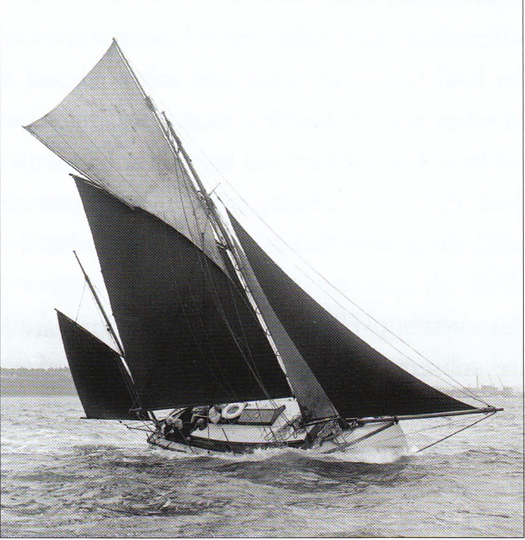
Mike Richardson's Betty racing in the first gaffers' race of 1959, four years before the OGA was formed. Her owner, who ran the famous Elephant Boatyard on the River Hamble, was a man of many sailing interests – he also was a regular offshore competitor with his S&S-designed fiberglass She 31 Arctic Skua. Photo courtesy OGA
Though the name of the Association and its burgee may have emerged fully formed in 1957, little else did. The first race wasn't held until 1959, off the River Hamble, and it became an annual event of sorts. But it was round on England's east coast in the Thames Estuary that the encouragement of the preservation of gaff rig found its most fertile ground, and on Saturday July 20th 1963 the Old Gaffers Race from the Blackwater to Harwich got going with 30 starters, though only seven finished as a forecast sou'wester became a light easterly.
The winner was one of the oldest boats in the fleet, Fanny of Cowes, and the OGA came formally into being. Despite the frustrations of that first East Coast Race, there were 35 starters the following year, when there was also a race for gaff-rigged yachts at the Royal Gourock YC in the Clyde. So there was clearly a grass roots movement of support for gaff rig at a time when plastic boats and alloy Bermudan masts seemed destined to wipe them out. But as many of the gaffers had eccentricity as their default mode, getting them into any cohesive organization was a slow process.
Yet over the years it has gradually developed, building up area associations, and based almost entirely on an enthusiasm for gaff rig and vintage craft which may be shared and displayed by people who do not necessarily have gaff rigged boats themselves, nor indeed vintage craft of any type. In fact, there's a significant segment of the membership made up of sailing folk who don't quite fit into any specific category, and nor do their boats if they have them, but the OGA provides them with a congenial spiritual home.
There has been a Northern Ireland branch since the late 1980s, while a Dublin Bay branch is of similar vintage, and in times past it was notably active when Dublin port and Howth were home to a vibrant flotilla of restored Galway hookers. But of course the revival of the Galway hookers was something which had been happening independently of similar movements elsewhere in Holland and England.
It was in 1974 that the last commercial cargo of turf was sailed out from Connemara to the Aran Islands on a hooker. Yet some of the old boats were kept going for the annual sailing events in the Land of the Sea, particularly the MacDara's Festival on July 16th. Then in 1976 Johnny Healion of Dublin appeared in Connemara with the magnificently-restored Morning Star, and the show was back on the road. I can vividly remember sailing from Clew Bay down to MacDara's Island in 1978 with the late great Tad Minish on his Finisterre yawl Kiff in order to witness the revitalized gathering of the boats and their racing, and the sense of a new spirit of enthusiasm being allied to a tradition half as old as time was palpable.
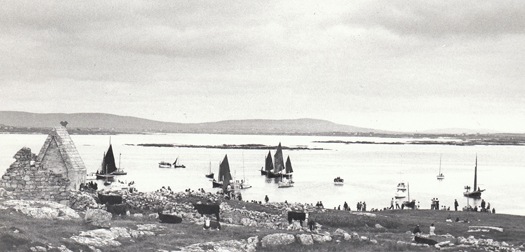
The traditional gathering of the Galway hookers at St MacDara's Island in Connemara, July 16th 1978. It was in 1976 that Johnny Healion had inspired the hooker revival with his restoration of Morning Star. Photo: W M Nixon
Thus the idea of an association simply devoted to venerating gaff rig seemed almost absurd in Connemara – what other sort of rig was there? But with goodwill on all sides, the boats of the west in their alternative times as boats of the east around Dublin Bay brought a huge infusion of sailing vitality to the Dublin Bay OGA, and with now-legendary regattas such as that at Portaferry at the entrance to Strangford, the message was spread.
Ironically, when the OGA itself had come into being in 1963, it was the very year that John Kearney was persuaded to oversee the conversion of the Dublin Bay 21s in Dun Laoghaire from gaff to Bermudan. But the Howth 17s have stayed loyal to gaff – complete with jackyard tops'ls – so as the Golden Jubilee of the OGA approached with the festivities planned for Dublin and Belfast, it seemed an ideal opportunity for the 115-years-old Howth 17s and the 50-years-old Old Gaffers Association to get together for the first time, and one of the people who worked behind the scenes on making this happen was DBOGA Committee Member Sean Walsh.
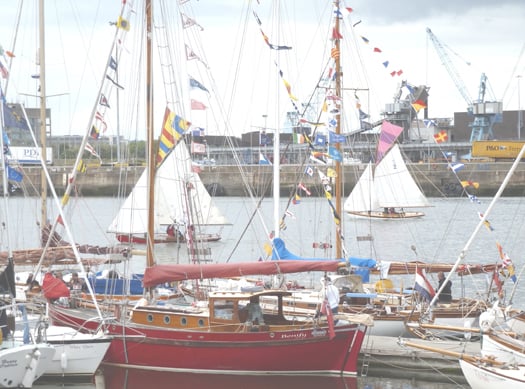
A dream comes true. The Howth 17s arrive in to join the OGA Golden Jubilee celebrations at Poolbeg Y & BC on Saturday June 1st 2013. Although the Howth 17s had been sailing under gaff rig for 115 years, and the OGA had been in being for fifty years, it was the first time the two groups had got together. Photo: W M Nixon
His life-story is a tale for our times. Born in Cork to a family north of the Lee, he was one of eight children, but as siblings appeared on an almost annual basis, he was effectively adopted by his aunt and uncle, who were childless. He cheerfully claims to have been spoilt rotten, but he grew up in a thoughtful household. When we remember that Cork was effectively Ford City in those days, the fact that his uncle drove a Morris Minor tells us much. It tells us even more that, when the little car needed new big-end bearings, his uncle educated young Sean into the ways of engineering and mechanics by having him as helper one Saturday morning while the uncle in his garage at home lifted out the engine, replaced the bearings with Sean to hand him tools and parts as required, and then re-installed the engine, all neatly in time for lunch.
His schooling was with the Christian Brothers at North Mon, where some of the Brothers took it into their heads to acquire an ancient little leaky fishing boat around 25ft long with a seized engine. They made it seaworthy or at least capable of floating, got the engine back to life, and based it at Kilbrittain on Courtmacsherry Harbour for a sort of informal sea training course for those pupils who had helped with the boat's restoration, which naturally included young Sean Walsh.
With his enthusiasm for getting afloat developing rapidly while still at school, having spotted the plans in a DIY magazine for a build-her-yourself 16ft canoe designed by Percy Blandford, he built three of these slim craft through two rooms in his parents' third floor attic. It was a neat building job, an elegant framework skinned by heat-stretching PVC sheet. His successful business plan was to sell two to finance his own ownership of the third. Getting them out of the attic was a hairy business which involved sending a messenger rope over the top of the house to provide a sort of crane, as the boats had to emerge cleanly and horizontally through a window still small despite the removal of its frame. But somehow they were safely lowered to a crowd of helpers far below, and the flotilla was ready to cruise.
And what a cruise they had, starting from the sacred location of Gougane Barra on the headwaters of the River Lee among the mountains away to the west, and spending three weeks descending the valley to Cork using wheels from a cannibalized Silver Cross pram to help them get the canoes through the many portages.
With hessian sacks made only slightly waterproof by a sort of plastic coating to provide a tent, and with eternally damp blankets rather than sleeping bags, it was a hardy life. But they throve on it and fed well with more than a little foraging, reckoning that the farmers owning the riverside potato fields wouldn't begrudge the three hungry young voyagers a feed of liberated spuds each night.
After school, Sean's first fulltime job was on the production line in the Dunlop Tyre plant, a Leeside institution back in the day. But even though with overtime he was soon earning enough to acquire a Triumph Spitfire sportscar, he was restless. In 1960s Cork, the class barriers were harshly drawn. But he yearned for something which provided outlets beyond the skilled manual work which seemed to be his allocation in life. He'd long been interested in radio, electrics and electronics, and the Radio & Electronics Institute in Cork provided a course which could qualify him as a ship's radio officer, so he sold the car to pay for the course.
As for transport, he was able to use his canoe to commute from home down the Lee to the riverside Institute – "I learnt a lot about tides". And in due course he qualified, and then was offered a job, due to start from Liverpool in five weeks time, as a Ships Radio Officer.
He had his new uniform bought and all when his aunt showed him an ad in the paper for electronic technicians up above in Dublin, working for some outfit called IBM. Those who would persuade the Irish to become a seafaring nation one and all should realize that they should be working on the womenfolk and their views on the matter. His aunt was secretly horrified at the thought of her beloved nephew going off to sea. So as he'd the five weeks to put in before he joined his ship, Sean did her the courtesy of applying for an interview, and in those pre-Google days, he went to the local library to learn a bit about IBM.
Anyone who has read the recent Steve Jobs biography will have learnt of the reverence with which IBM is held in the grown-up business community. Back in the 1960s, the company was at the exciting stage of building up its unrivalled reputation. It looked like a stimulating place to work, and young Sean Walsh was so interested by what he'd read about it that he sailed through the interview, within a week he'd been offered a job which in 1969 began his 36 year career with IBM, and the Radio Officer's uniform went into the wardrobe.
But while he may have been working in IBM computers for some of the key companies in Ireland and living in Dublin, if anything his interest in boats increased, and now it encompassed sailing. Having proven his business plan with the success of building three canoes and keeping one for himself, in the front room of his first house (it was in Portmarnock) he built three Fireballs, and after they'd been approved by the class measurer, a young fellow called David Lovegrove, he was able to sell two and keep the third to teach himself to sail on Broadmeadow Water in Malahide, most of which is a safe depth which means you can stand up when you capsize. As he did a lot of capsizing learning to sail a Fireball single-handed, he did a lot of walking around in water up to his chest.
But he learnt to sail too, and got involved with the sailing scene at many levels. Like a lot of men with young sons, he built a Mirror dinghy and did miniature cruises. Then at another stage in life, he was active as an instructor in Glenans. Having been self-taught in sailing, he had much to contribute at the Glenans base on Clew Bay.
However, the more he became involved with boats and sailing, the more he found himself drawn to traditional craft, and gaff rig. Meanwhile his career with IBM was blossoming as the company became world leaders. In a new setup in which, instead of selling products, their philosophy was to provide a total package of solutions, he found himself becoming a project manager. IBM had discovered that with computers, somebody with a technical background talking with genuine enthusiasm about what the machines could do was actually much better at selling to hard-headed executives than the traditional salesman with his shallow patter.
So in this multi-functional role, he went along for a first meeting with the Financial Controller of Readymix Concrete, who'd expressed interest in an IBM system. In preliminary pleasantries, Sean said something about the peculiar weather. The FO agreed, saying it was unusual to get so many sou'easters at that time of the year. So Sean took a conversational flyer:
"What kind of a boat do you have?"
"She's a bit unusual. She's called a Heard 28. She's a gaff-rigged cutter, looks old style but has a fibreglass hull. She's a super boat."
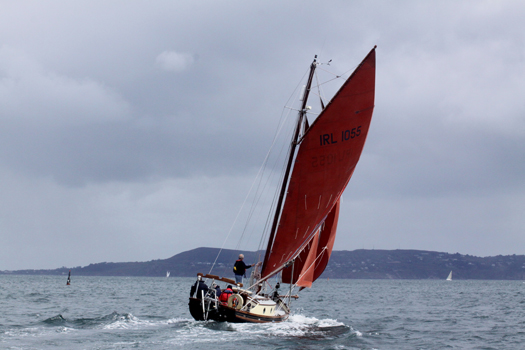
Storming along. Tir na nOg is a Heard 28, designed by Percy Dalton and based on the Falmouth Working Boats which are legally required to dredge for oysters under sail only. The Heard 28 is one of the most successful of the "plastic gaffers" which now form a significant part of the fleet of the OGA. Photo: Dave Owens
Thus did Sean Walsh meet Gerry McEvoy, owner of the Tir na nOg of Howth. They talked boats for a solid two hours, then - the working day being long over - agreed within five minutes the outline of the system IBM would provide for Readymix. And then, once the system Sean designed was installed and working satifactorily, he accepted an invitation to go sailing on Tir na nOg, and now, 22 years later, has been sailing on her ever since.
Sadly, after a number of years of being shipmates together, Gerry was to die cruelly young. But in partnership with another sailing friend, Gerry Murtagh, Sean bought Tir na nOg himself. It was in 2003 that they sailed into Howth Harbour and were invited into an assembly of gaff rigged boats convivially gathered at Howth Boat Club at a Dublin Bay Old Gaffers Association event. As the evening went merrily long, a sister-ship of Tir na nOg's came into port and joined the party. It was Englishman Mike Shaw and his son, cruising round Ireland with the Susan J.
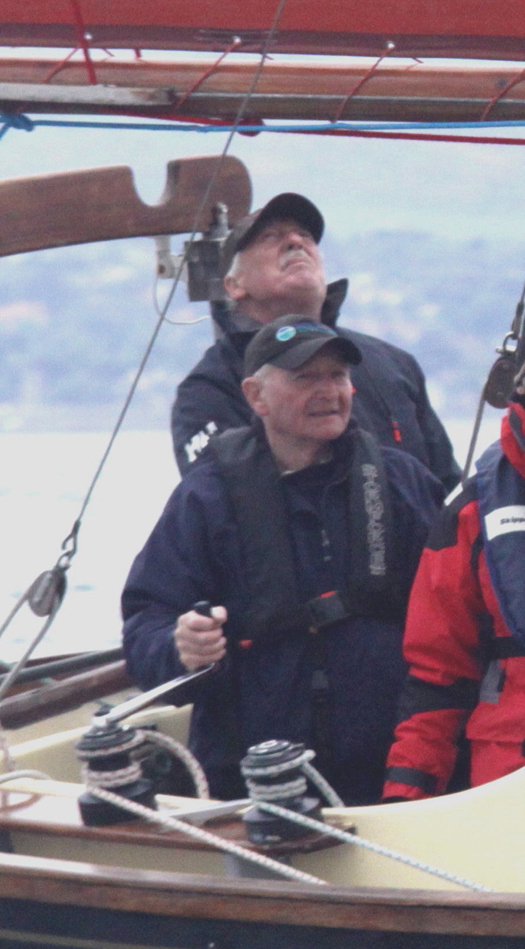
The top men. Mike Shaw (foreground) crewing for Sean Walsh (on helm) aboard Tir na nOg during the race for the OGA's Leinster Plate in Dublin Bay Photo: Dave Owens
Mike was a longtime Old Gaffers Association stalwart, so Sean Walsh found himself getting the OGA message both at local and central levels in a big way. He embraced the concepts of the organization with such enthusiasm that, in the eleven years since that fortuitous meeting in Howth, he has served on the Committee of the Dublin Bay OGA, and as its Honorary Secretary and DBOGA President. And he has also been on liaison duties with headquarters where his friend Mike Shaw was being quietly positioned in order to be President when the Golden Jubilee came around in 2013. Thus when the OGA Golden Jubilee Round Britain fleet came west to Ireland in June 2013 for major events in Dublin and Belfast, Sean had the satisfaction of seeing his hopes of the Dublin fleet, well supported by the Howth 17s, make the Riverfest in the Liffey and the two special races in Dublin Bay into one of the outstanding events of the entire Golden Jubilee.
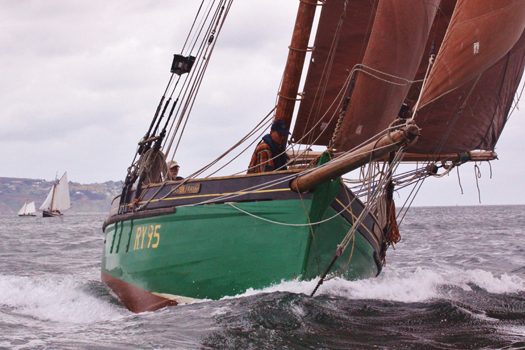
The OGA's fellowship of the sea. Noted Irish explorer and traditional boat sailor Paddy Barry is just visible at the helm of Joe Pennington's 1895-built Manx longliner Master Frank as they prepare to start in the race for the Leinster Plate in Dublin Bay. Photo: Dave Owen
After such a year, the following season might threaten to be a bit of a downer for the OGA, but the new President doesn't see it that way. Though he turns 70 this year, Sean Walsh is full of beans, and while he may have retired from his long and successful career at IBM, he's not he retiring type. From the work point of view, he keeps himself busy as the Yanmar Marine Engines agent for Ireland's east coast, for there's no way he's going to let all that engineering talent and experience go to waste.
And as for the continuing development of the OGA, he's fairly bubbling with ideas. His own lifetime experience is invaluable in helping the Association develop its concepts about the best ways of introducing young people to sailing and traditional boats, and keeping them interested. As for his unrivalled experience in computers, that too is of unique value for an association which, while specializing in traditional craft, relies increasingly on the latest technology to spread its messages and keep its boats and people records up-to-date.
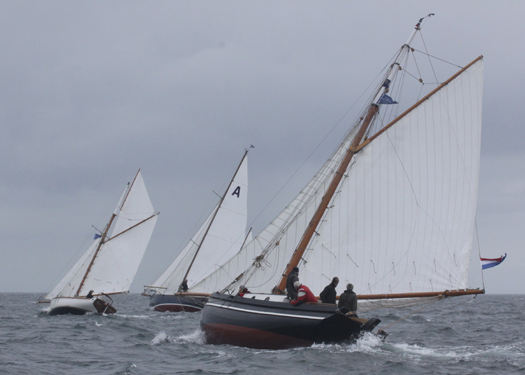
Dutch sandwich. Ainmara (Dickie Gomes, Strangford Lough) seen between Raven (left) Fred Schottman, Makkum, Holland, and Cine Mara (Rik Janssen, Makkum) shortly after the start of the race for the Leinster Plate in Dublin Bay. The Dutch boats made up the largest contingent which went right round Britain for the OGA Golden Jubilee, and in 2014 they will be celebrating the tenth anniversary of their own branch of the OGA with a cruise-in-company in The Netherlands. Raven is a Lyle Hess 28 while Cine Mara is steel built based on the classic Galway hooker design. Photo: Dave Owens
As for life afloat, while 2013 was the Golden Jubilee of the central association, 2014 is the Tenth Anniversary of the lively Dutch branch. The Dutch boats were among the stars when the OGA came to Dublin last June, and their planned cruise-in-company for all interested OGA members through the incomparable waters of the Netherlands in July this year is expected to be the highlight of the season.
So when I met the new President shortly after his return from London this week and considered the demands on his time with the many active local branches, the up-dating of central administrative systems, and the special demands of the Dutch celebrations, I could only suggest that he was going to need a fulltime Personal Assistant.
"I have one already" said Sean Walsh, "I meet him first thing every morning when I look in the mirror".
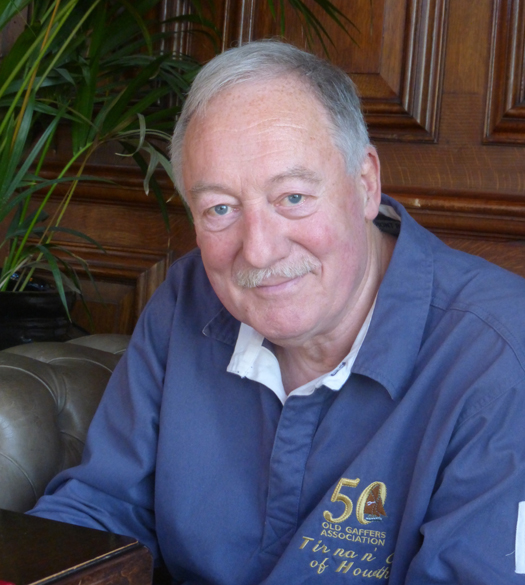
Sean Walsh, eleventh President of the Old Gaffers Association. Photo: W M Nixon



























